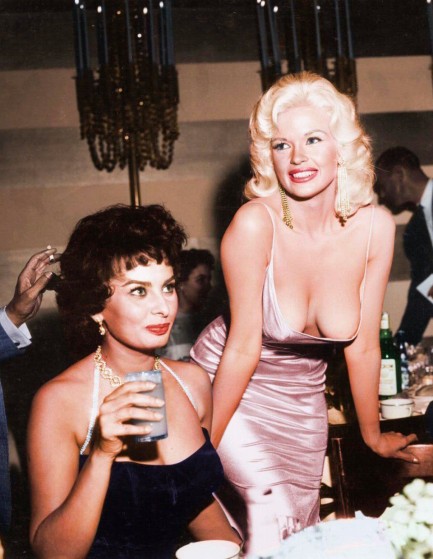| Femmes Fatales | Feb 2 2024 |

Rub-a-dub-dub, Jayne bubbly in a tub.
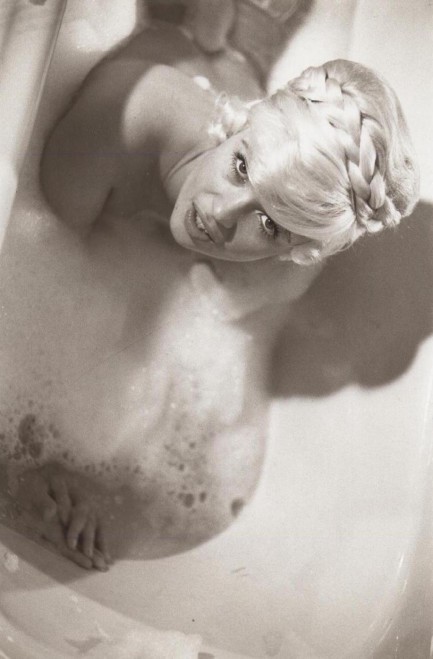
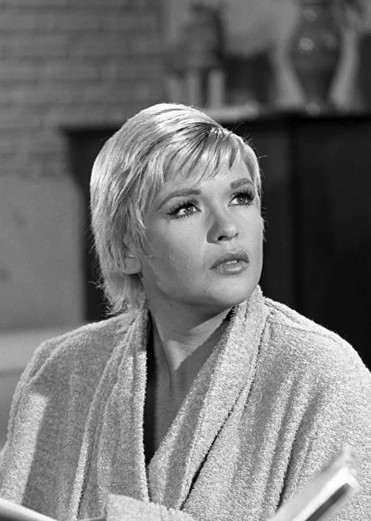 Above: Jayne Mansfield poses in a bathtub with yet another of her unusual hairdos. We're thinking it's probably a wig, in whole or in part. She wore wigs often, but her real hair was almost a trademark. Even so, she was never afraid to cover it for the sake of a good shot. She even cut it occasionally, with excellent results, such as you see in the 1962 photo at right. We don't have an exact date on the bubbly tub image, but most sources place it around 1960. Want to see one her wildest hair-dos? Click this link.
Above: Jayne Mansfield poses in a bathtub with yet another of her unusual hairdos. We're thinking it's probably a wig, in whole or in part. She wore wigs often, but her real hair was almost a trademark. Even so, she was never afraid to cover it for the sake of a good shot. She even cut it occasionally, with excellent results, such as you see in the 1962 photo at right. We don't have an exact date on the bubbly tub image, but most sources place it around 1960. Want to see one her wildest hair-dos? Click this link.
| Intl. Notebook | Jul 1 2023 |

How many can you consume in one sitting?
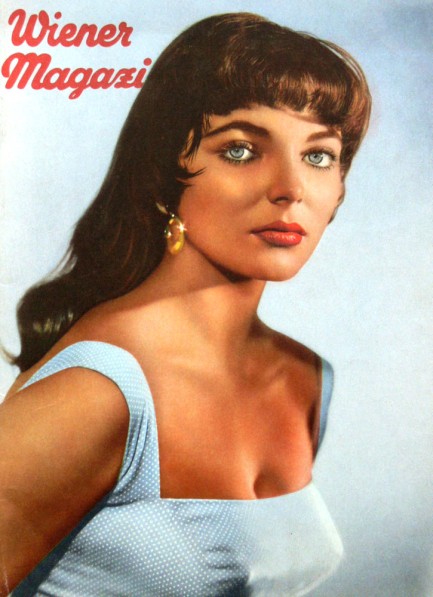
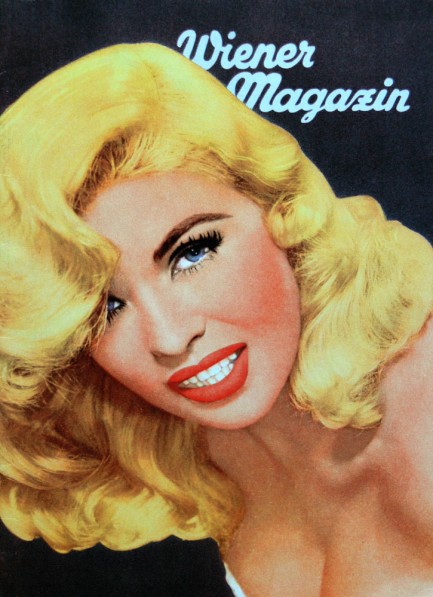
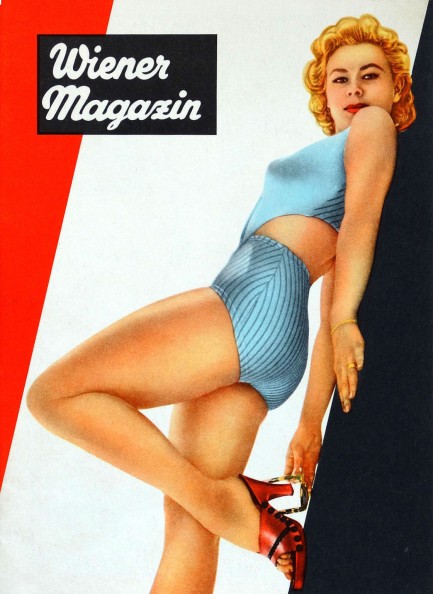

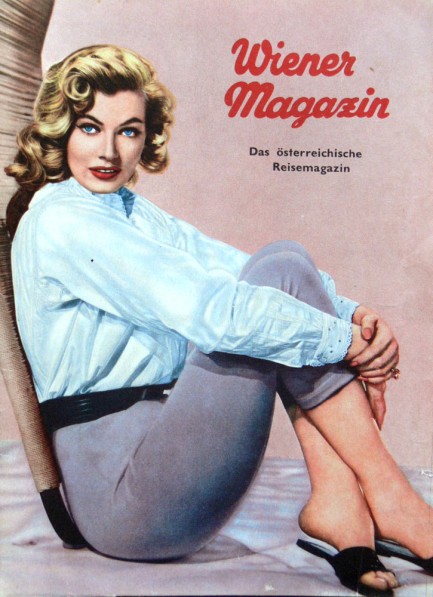
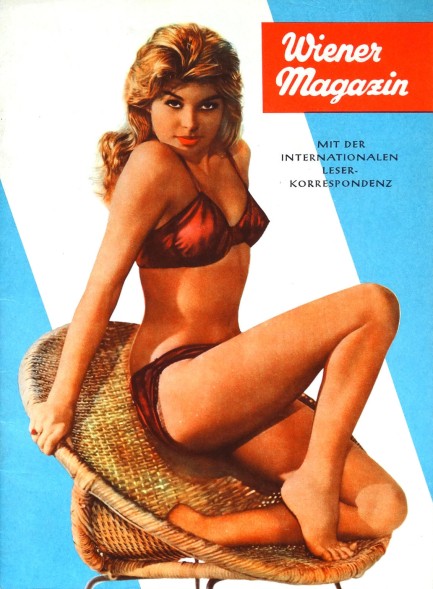
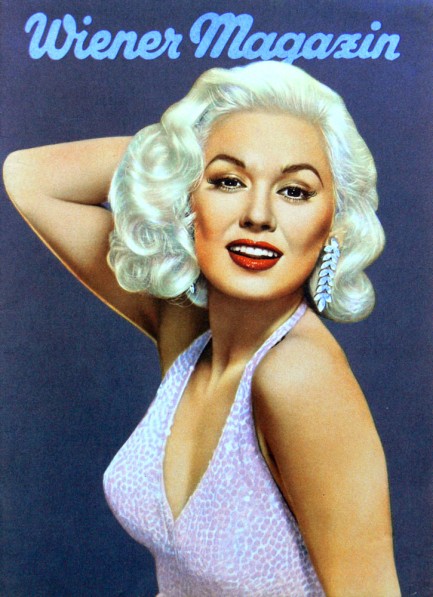
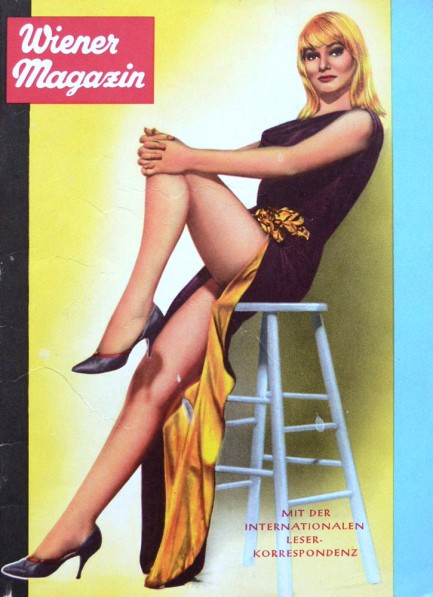
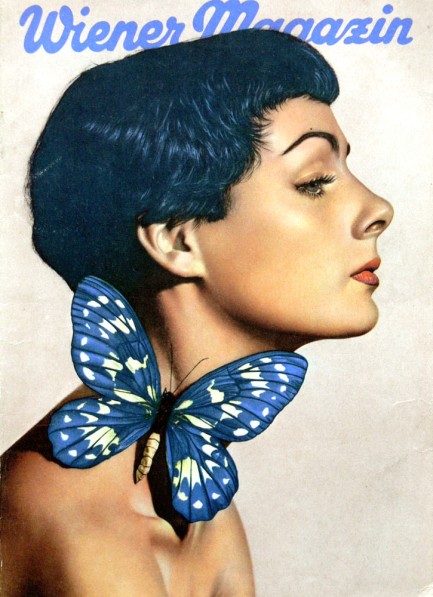
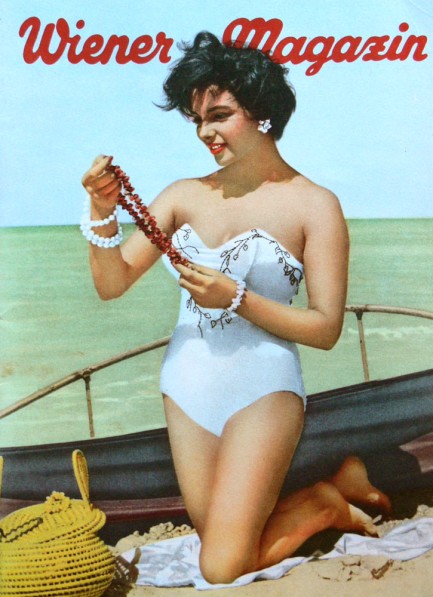
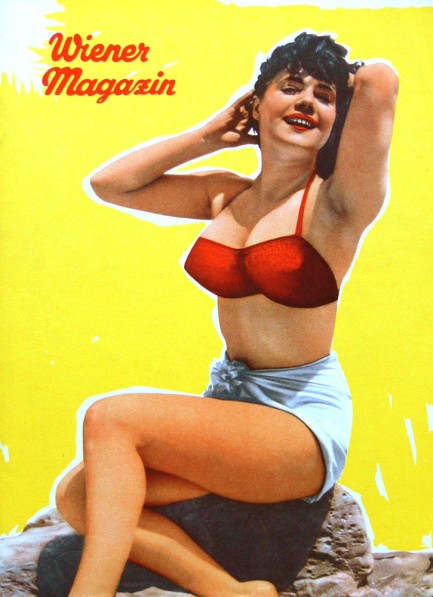
Above are lovely photo-illustrated covers of Wiener Magazin published in Austria during the 1950s. Some of the celebrities pictured are unknown to us. We've placed those last. The others are, in order, Joan Collins, Jayne Mansfield, Mitzi Gaynor, Ava Gardner, Anita Ekberg, Lilanne Brousse, Mamie Van Doren, and May Britt. These are to whet your appetite. We have a couple of full issues we'll show you later.
| Femmes Fatales | Mar 6 2022 |

Heavy is the head that wears the oversized platinum blowout.

This photo shows Hollywood bombshell Jayne Mansfield sporting an astonishing candyfloss coiffure backstage at the Dunes Hotel in Las Vegas in 1964. The hair—let's just say it—is fucking strange and must have taken at least an hour to sculpt, or maybe it's a wig. Either way, it befits her larger-than-life stature. When you're as big a celebrity as she was you have to set tongues wagging every time you appear in public, because once they stop it's all over. The game remains unchanged today, but few have played it as well as Jayne.
| Vintage Pulp | Feb 21 2022 |

I asked for a double room so we can use one bed for action, and the other for recovery.
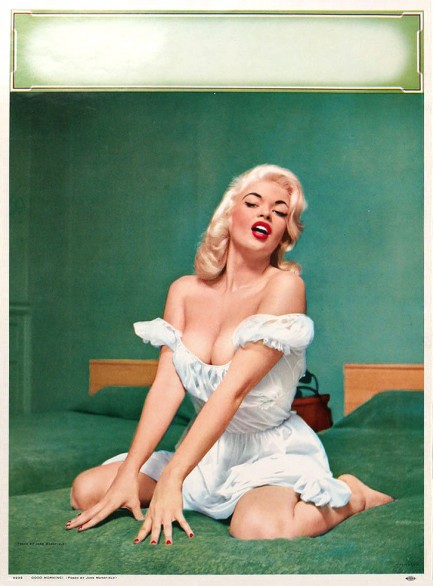
Above is a 1960 Technicolor lithograph starring Jayne Mansfield. It's called, “Good Morning,” which we suppose it might be if you woke up with her. The shot originated from 1956 and was first used on a cover of Cabaret Quarterly. It was later used on Modern Man in 1960, Beau magazine in 1966, and even—with the background changed to pink—Mark Gabor's 1984's Illustrated History of Girlie Magazines. It probably showed up elsewhere too, and why not? It's one of Mansfield's best shots.
It's been a while since we shared one of these Technicolor lithos, so as a reminder we'll mention that they were made as a potential market replacement for the painted pin-ups of earlier years, such as those produced by Gil Elvgren, Art Frahm, and Zoe Mozert. That's why these have such painterly compositions. You can see for yourself, because we have a bunch of examples going back years, and some of them are amazing. Just click here and scroll.
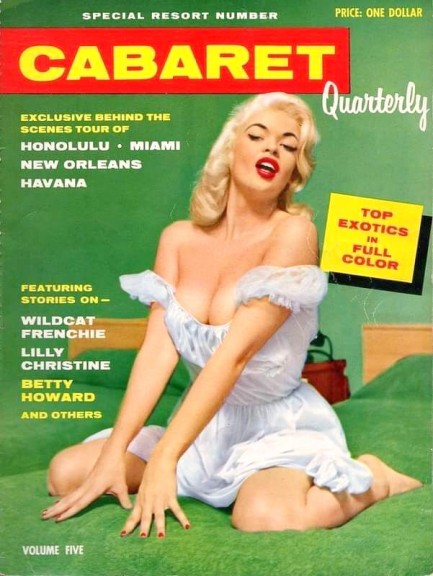
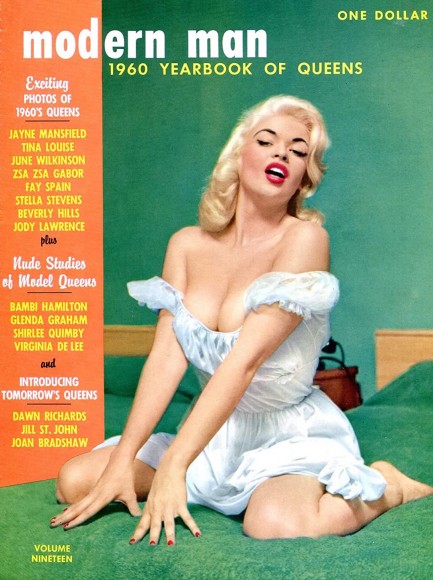
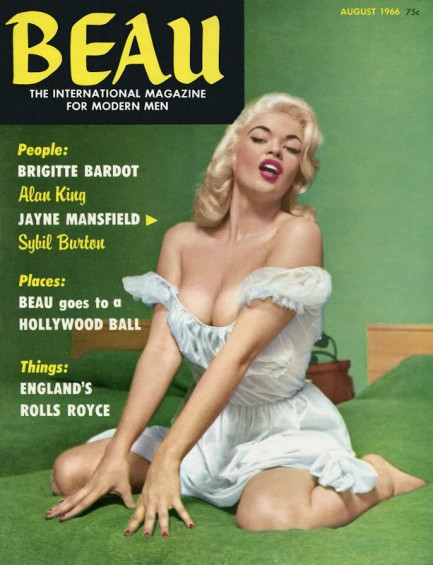
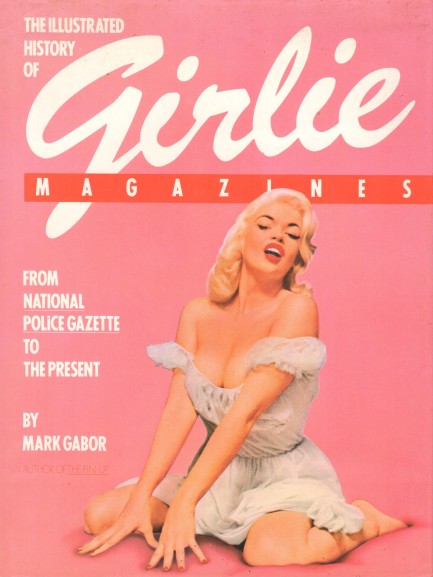
| Vintage Pulp | Nov 14 2021 |

Vintage glamour magazine produces treasure trove of rare celebrity photos.
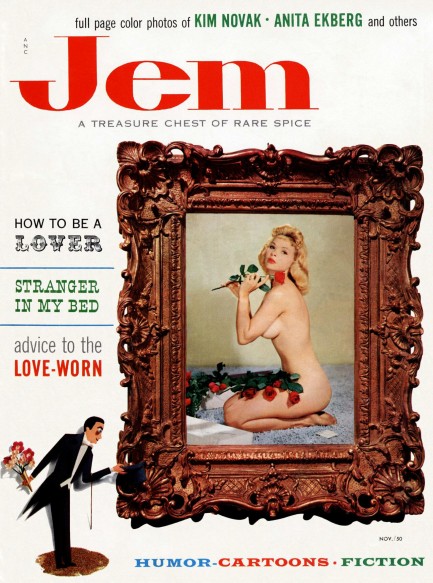
Above you see the cover of Jem magazine, founded by famed bodybuilder Joe Weider as one of the first high budget competitors to Playboy. He also launched the similar imprint Monsieur. The scans above and below are from the very first issue of Jem, published this month in 1956. It came out during the heyday of the era when magazines of this type gave equal billing to Hollywood celebrities and erotic stars (something we try to emulate on Pulp Intl.), which means you'll not only see rare photos of actresses like Anita Ekberg, Jayne Mansfield, and Kim Novak, but also burlesque dancer and model Candy Barr (on the cover and in the beautiful masthead page), model Betty Brosmer (who was Weider's wife), and dancer Lili St. Cyr. Jem also poached July 1956 Playboy centerfold Alice Denham, which must have served as a shot across Hefner's bow. In addition to all those attractions, you get illustrations by Dwight Howe, Ken Wyeth, John Martin, and Jack Lyons. The magazine is so vibrant we uploaded every page that had either photos or art, making for a whopping fifty panels to enjoy below. We found this on Archive.org, but we're going to see if we can locate a few in real life.
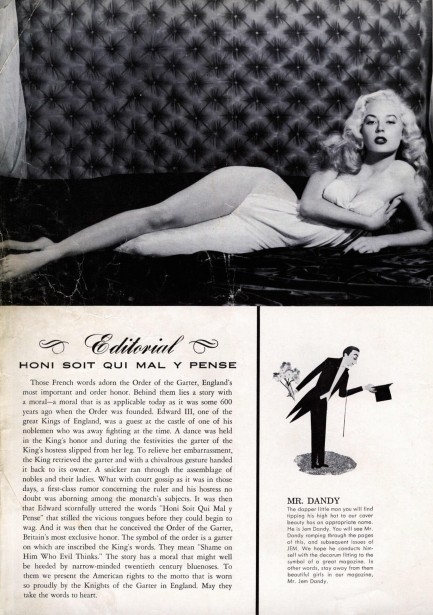

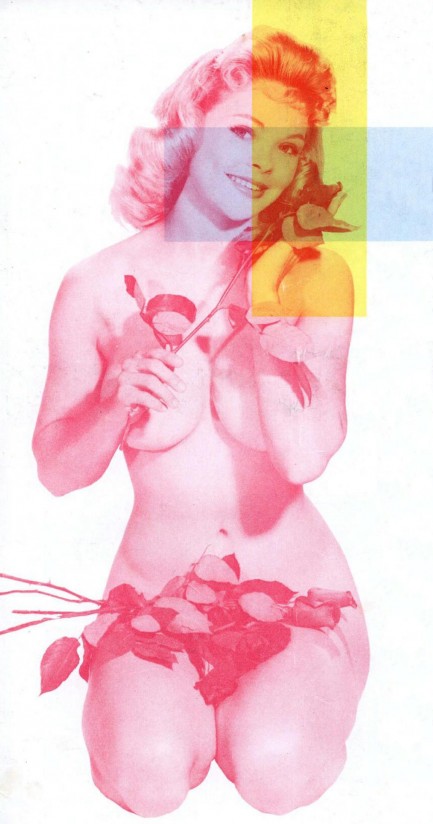
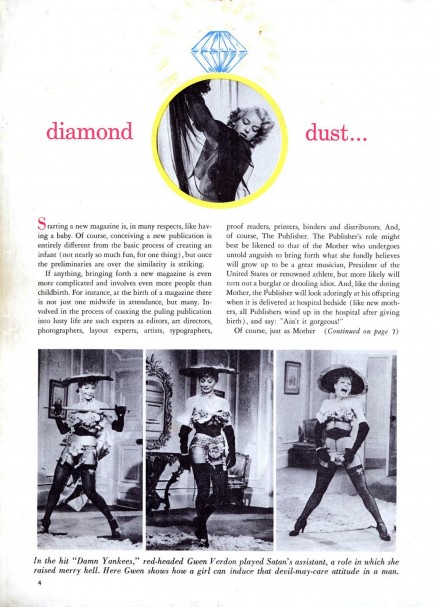
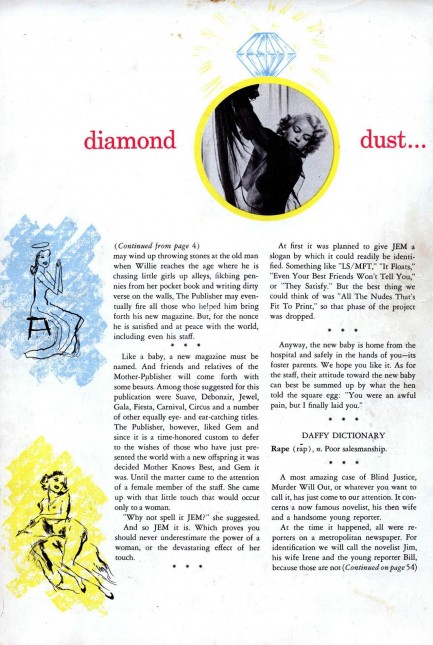
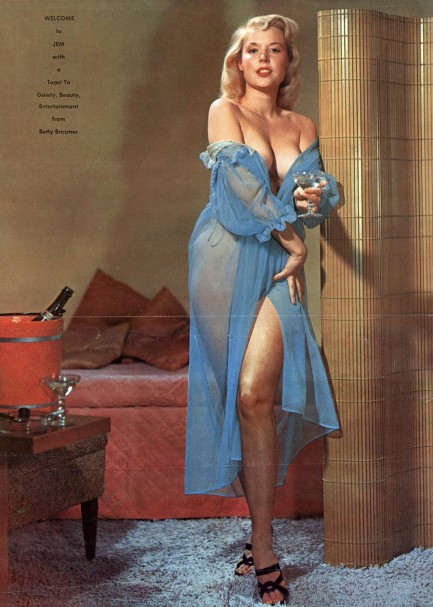
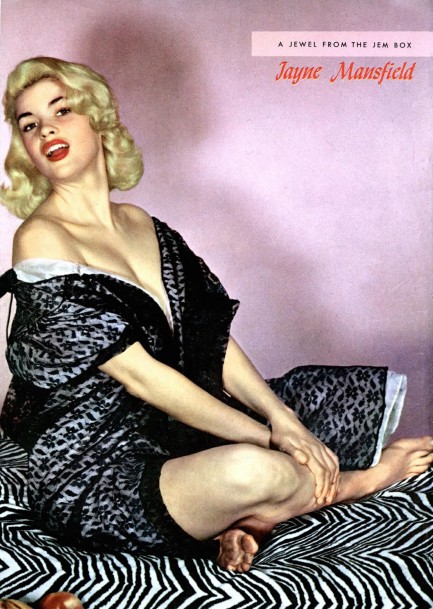
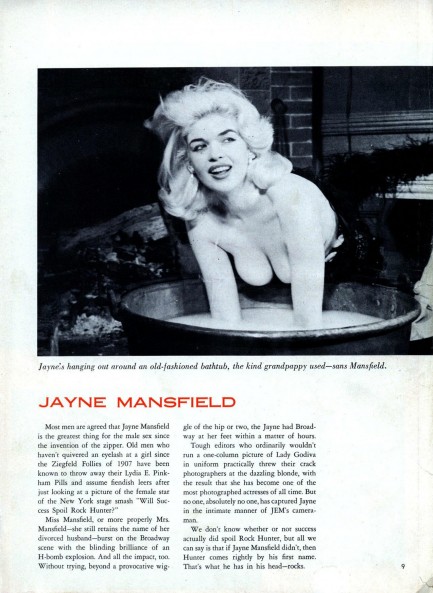
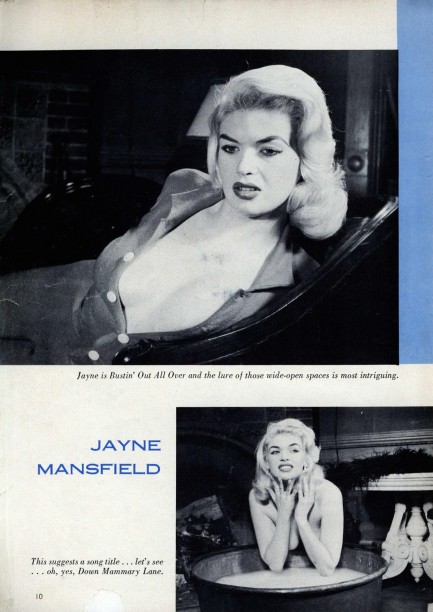
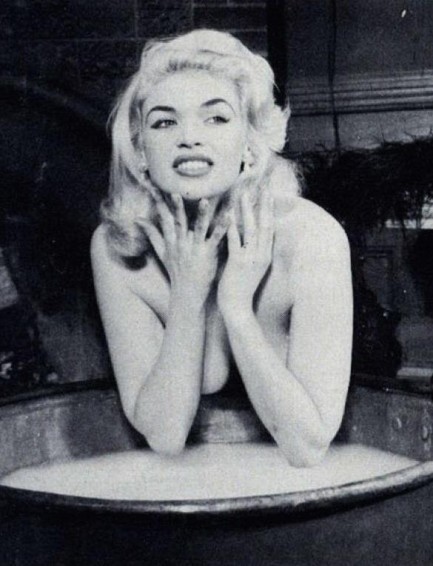
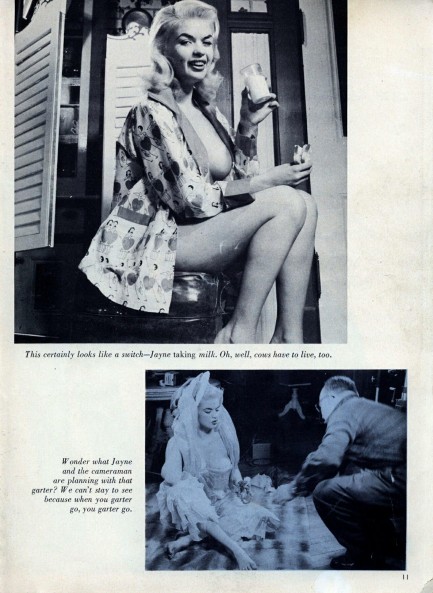
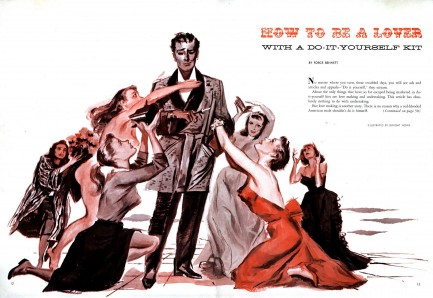
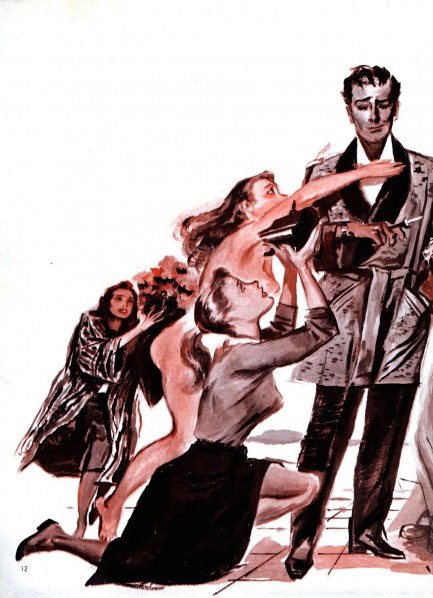
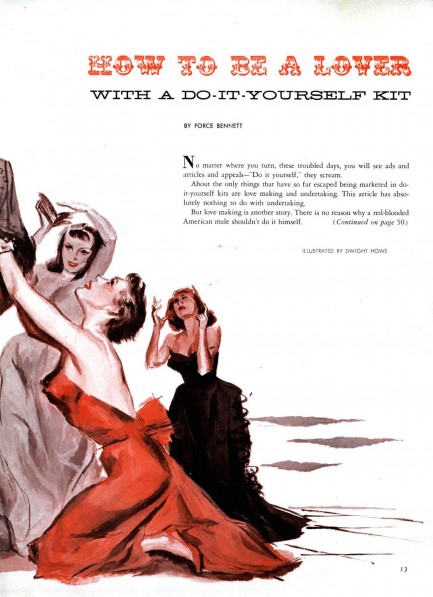
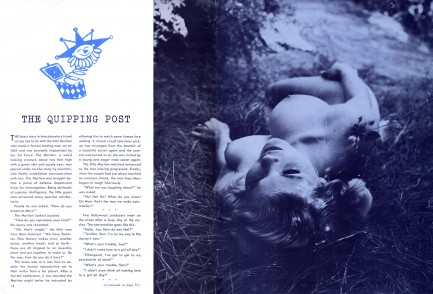
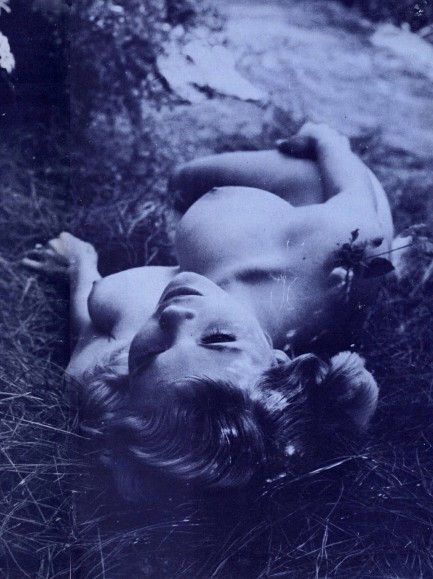
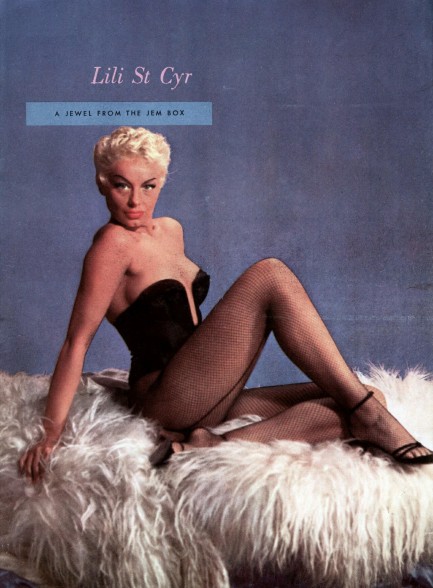
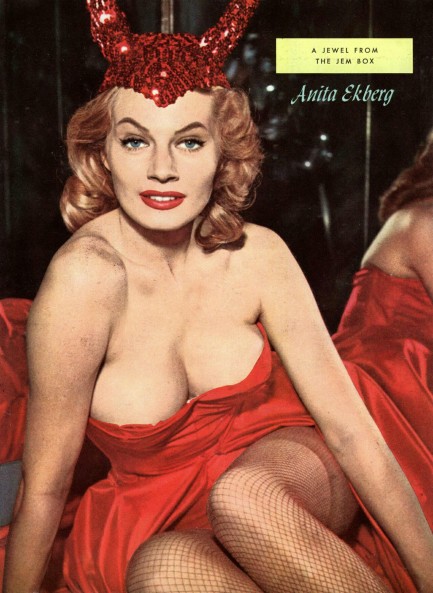
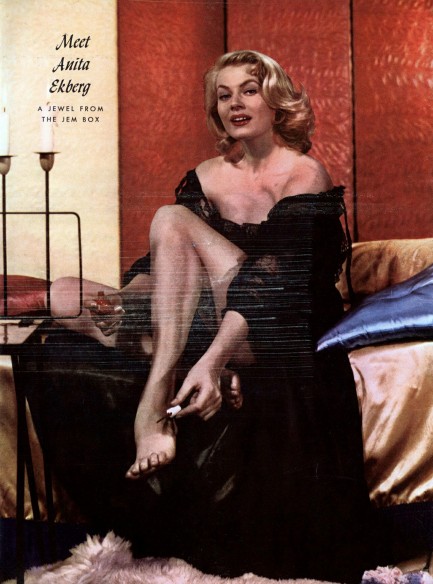
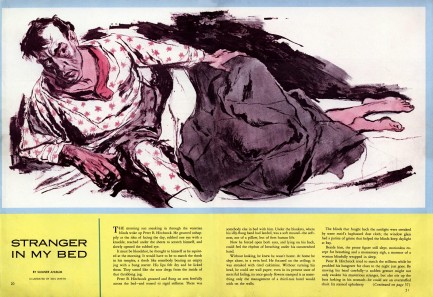
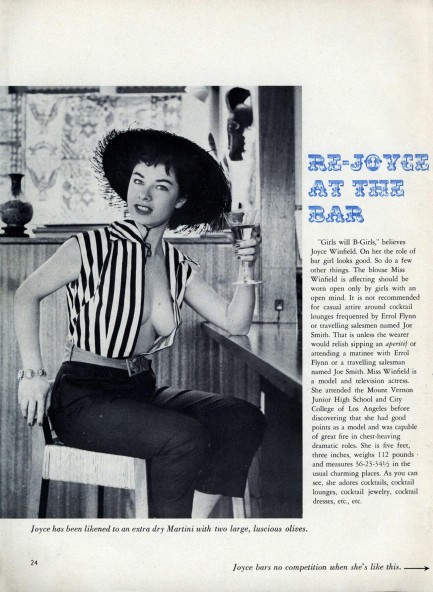
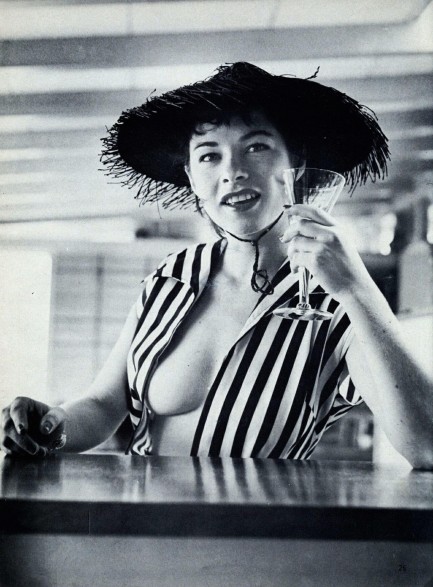
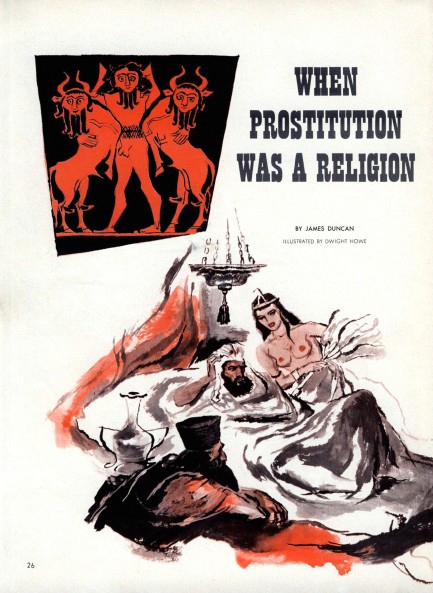
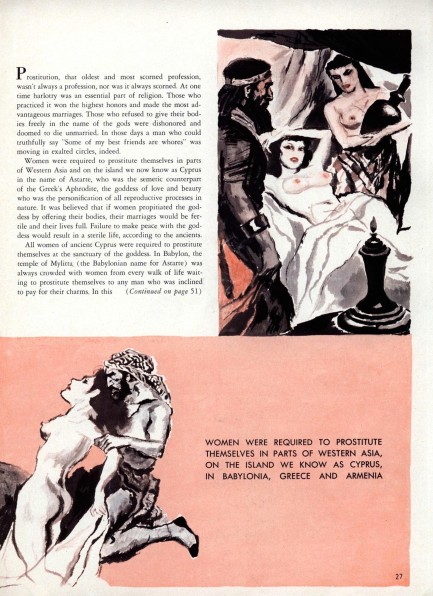
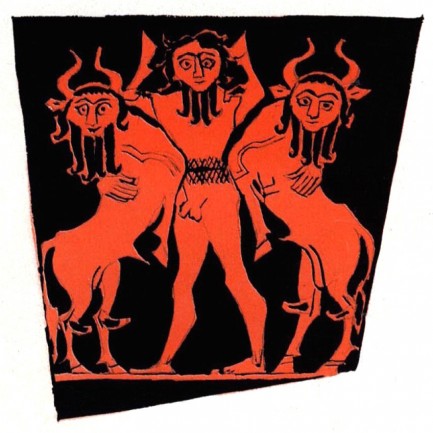
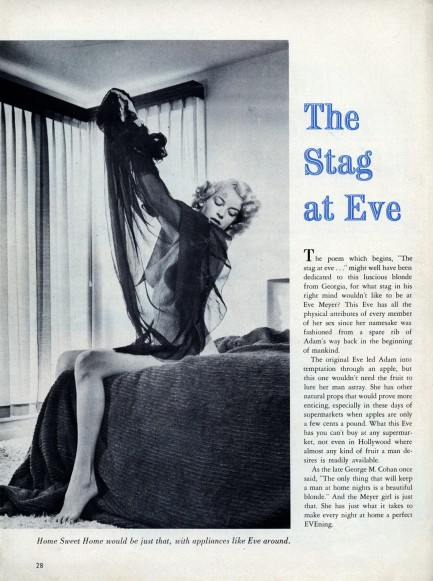

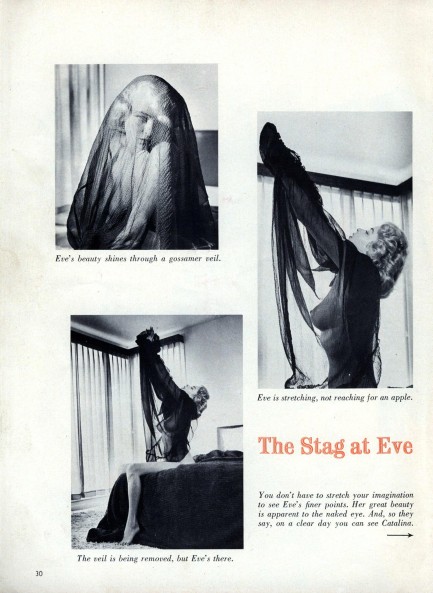
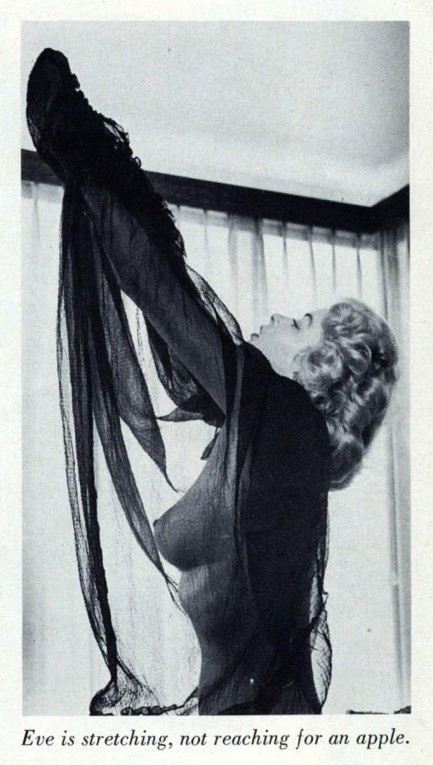
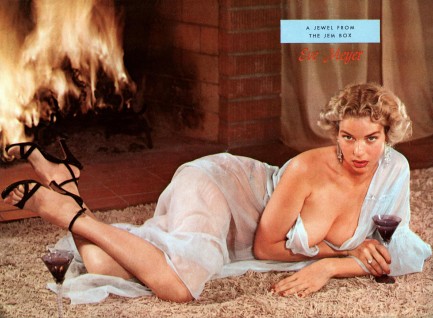
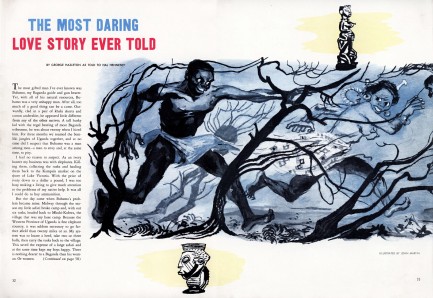
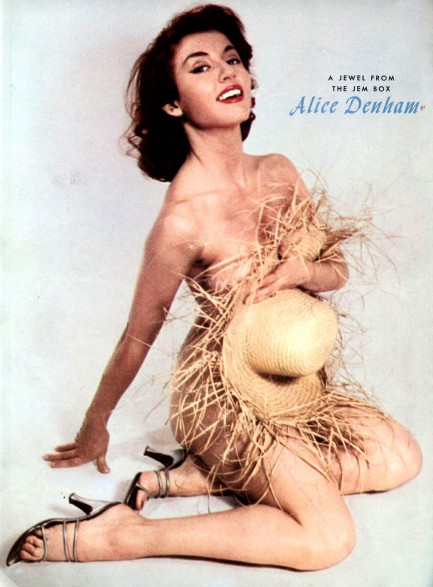
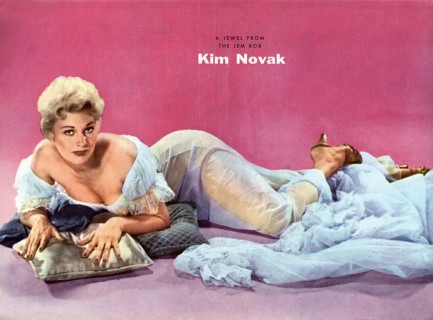
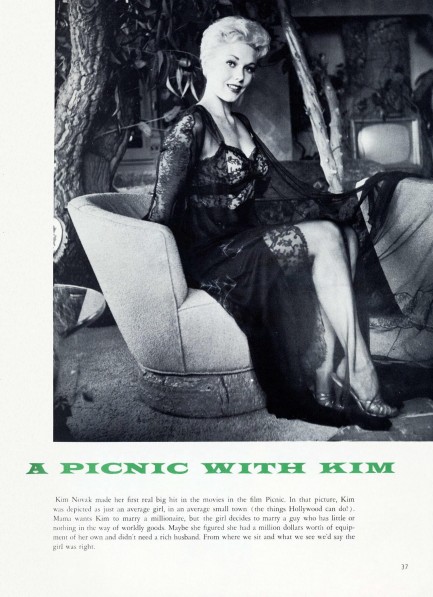

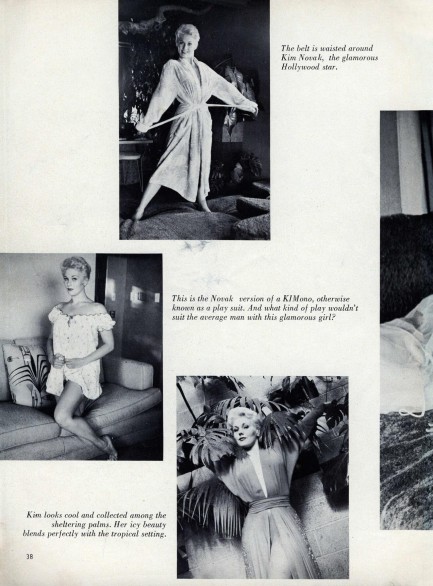
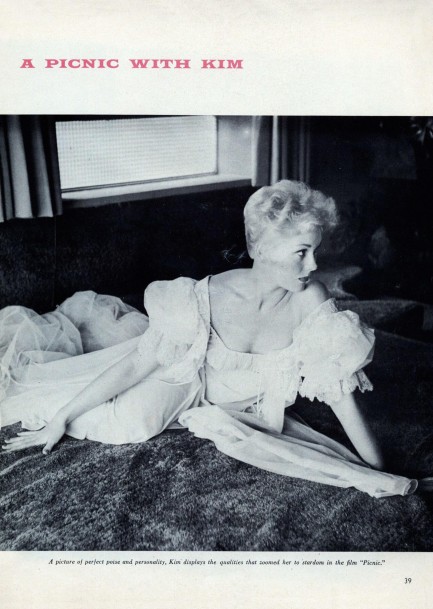

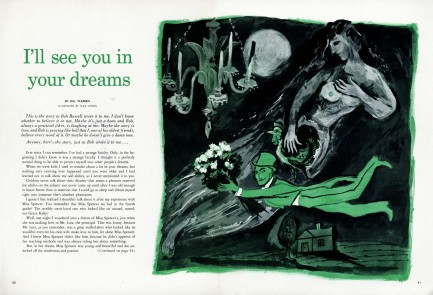
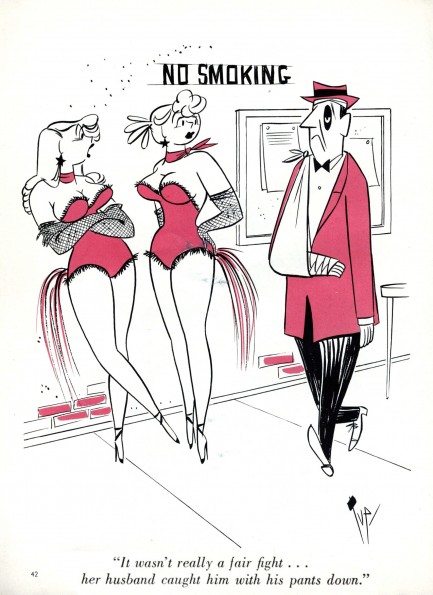
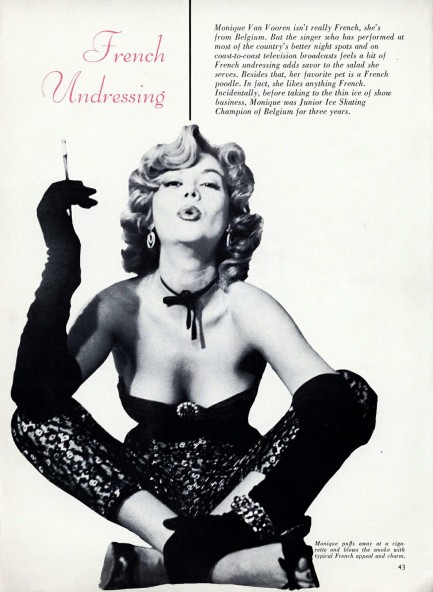
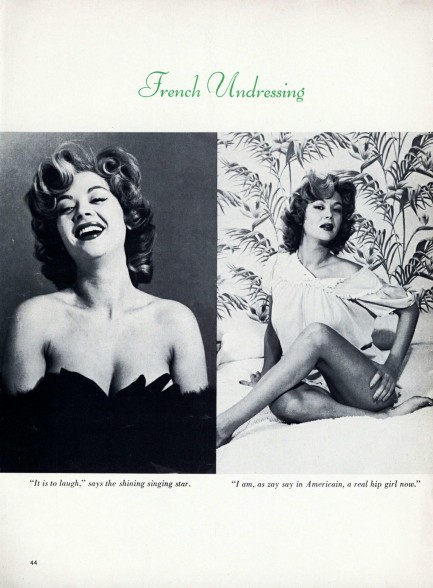
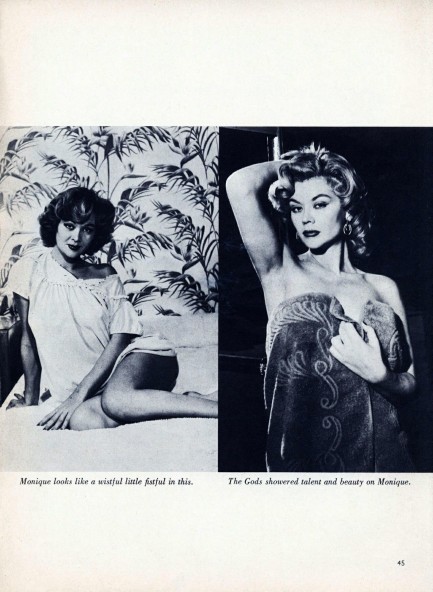
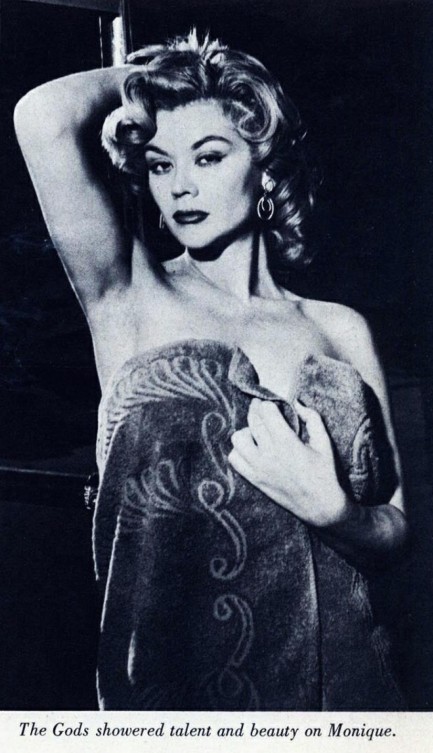
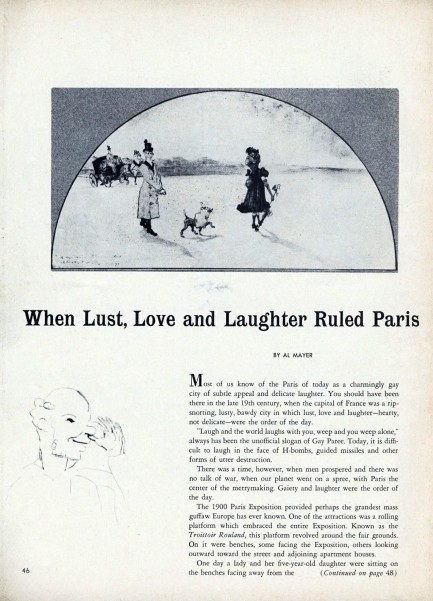
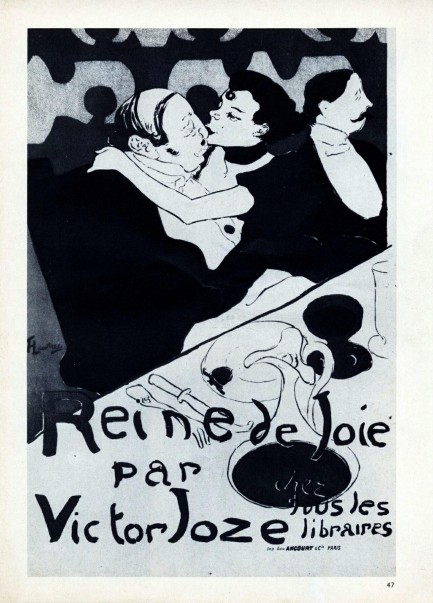
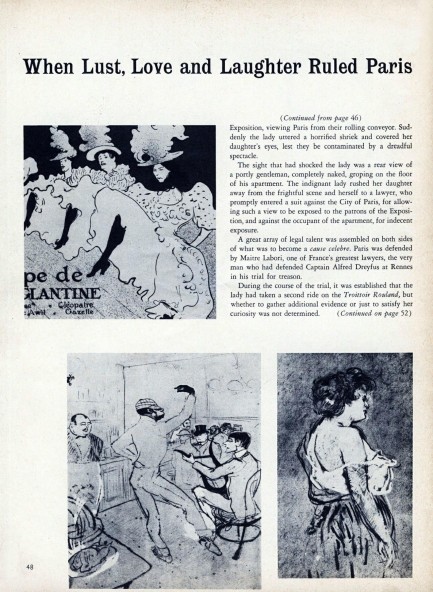
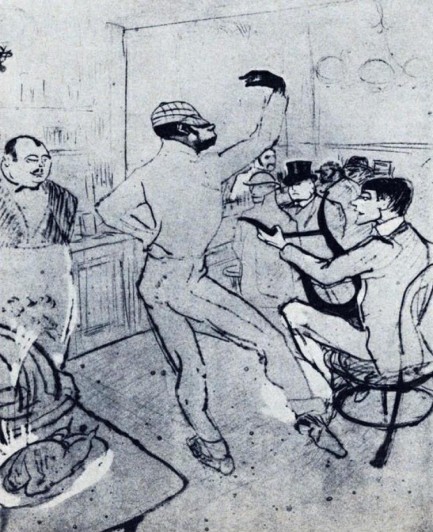
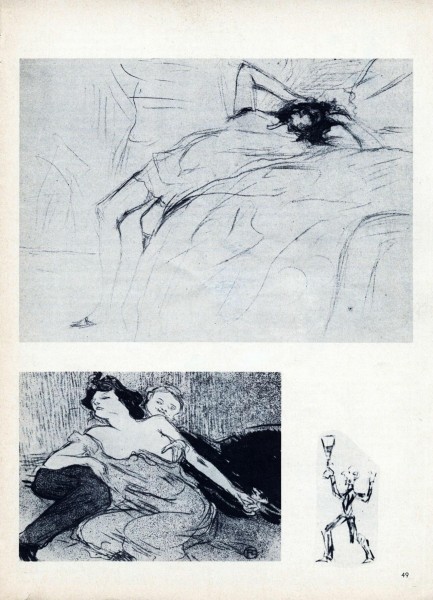
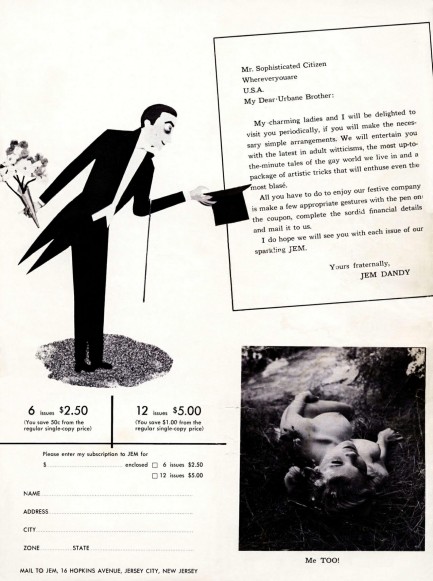
| Vintage Pulp | Aug 2 2021 |

When Mansfield makes a promise she keeps it—and then some.
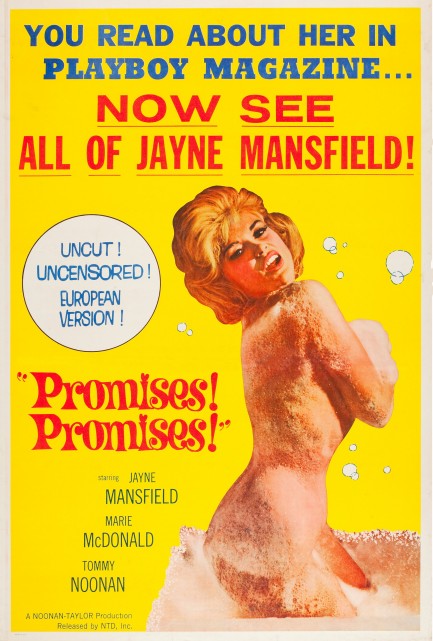
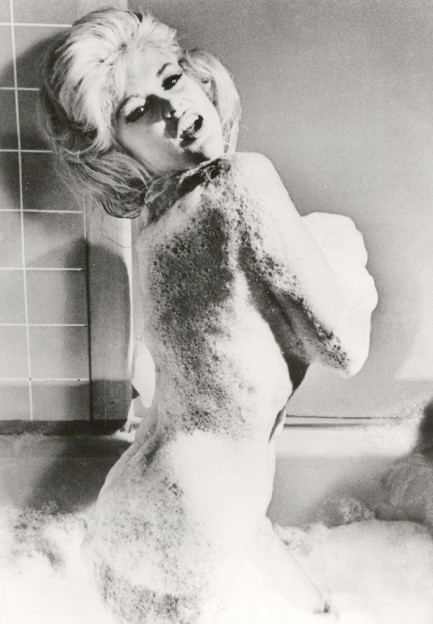
Check out the poster at top for the infamous Jayne Mansfield movie Promises! Promises! It's so garish it almost hurts the eyes, but we think it's top notch, a framable classic made for an important cinematic landmark. Around the time this film was produced, Hollywood, for both financial and artistic reasons, was pushing the boundaries of censorship. There had been nude scenes prior to the advent of the creativity-strangling Hays Code, but from the mid-30s to 1960s there were no naughty bits onscreen. Europe was well ahead in that regard, with late 1950s films such as And God Created Woman taking advantage of greater freedoms to include snippets of nudity by major stars. In the U.S., low budget nudie flicks were being made, but no legit star had crossed the line. Marilyn Monroe probably would have been the first, but her flash in 1961's The Misfits was cut, and 1962's Something's Got To Give was never completed.
Cue Mansfield—also so garish she almost hurts the eyes—suffering from a career slump and deciding to seize the nude crown with both hands. Promises! Promises! falls into that classic American category of the schlub sex comedy, which is to say, the lead male is an unremarkable everyman miraculously paired up with a beauty. This formula holds true in American movies and television even today—think Big Bang Theory or Ross from Friends. The plot deals with two childless married couples on a cruise who get pregnant but suspect it happened because the husbands cheated with each other's wives. It sounds like a ripe concept, but unfortunately the filmmakers forgot one of the main ingredients necessary for a sex comedy—laughs. Promises! Promises! is borderline moronic.
But bad movies often make a mint. The producers' bet that audiences wanted to see Mansfield nude was correct. Sophomoric as the resulting film was, it was a big hit, though only non-U.S. filmgoers got to see the uncensored version at first. That's the one we watched, and the promise of a skinful experience was fully delivered—and then some. While Mansfield doesn't show her girlfur, she's naked as a Jaynebird from every angle, and her bare segments are also shown as flashbacks several times to let audiences relive those golden moments. To say she broke the censorship barrier is an understatement. She splintered it and stomped the pieces while screaming at them to stay down. So if you watch this you'll not only be flirting with a boner—you'll be watching a legitimate historical landmark. What more reason do you need? Promises! Promises! premiered in the U.S. today in 1963.
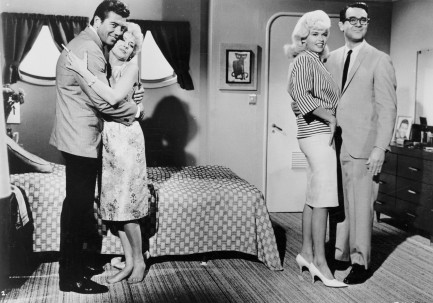
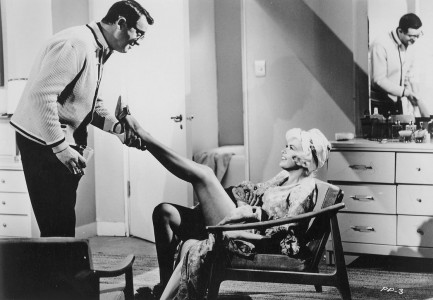
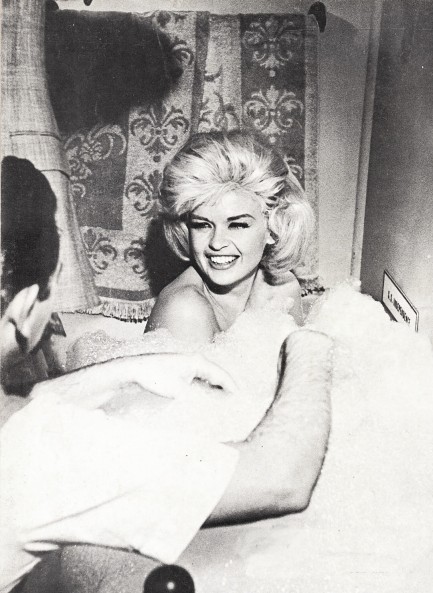
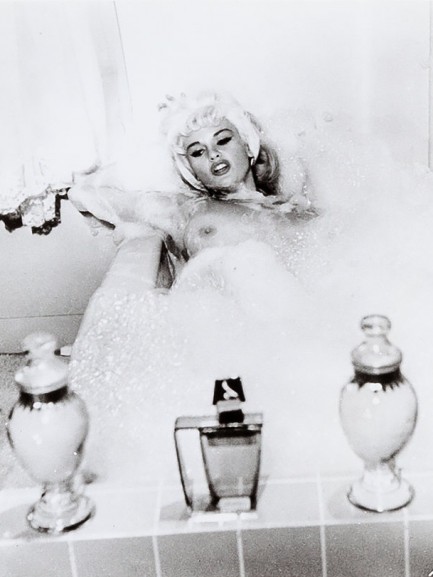
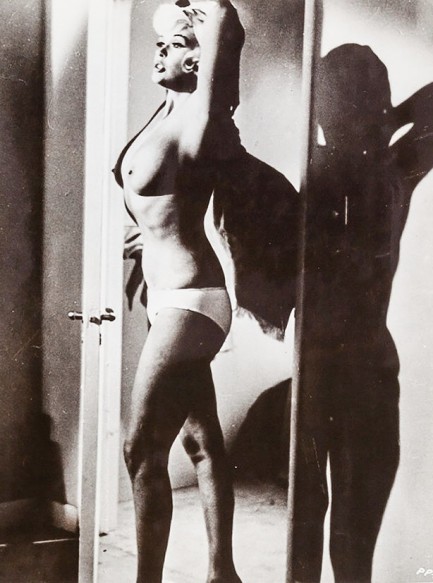
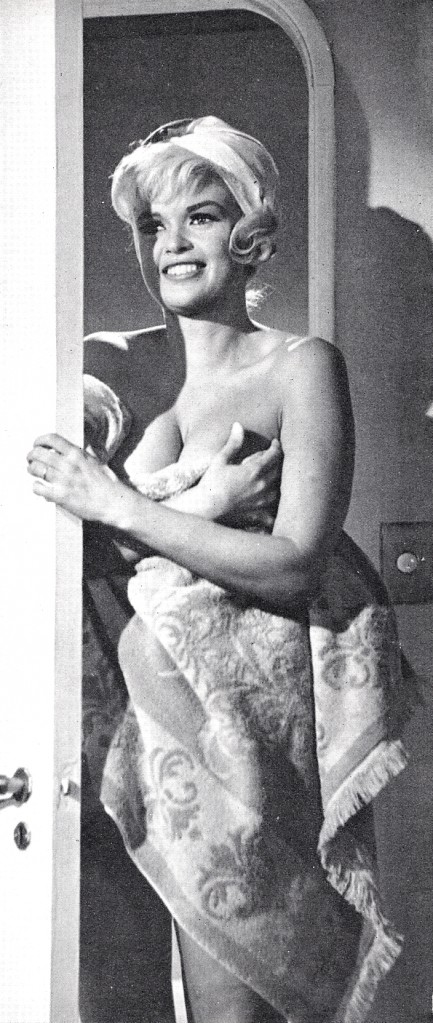
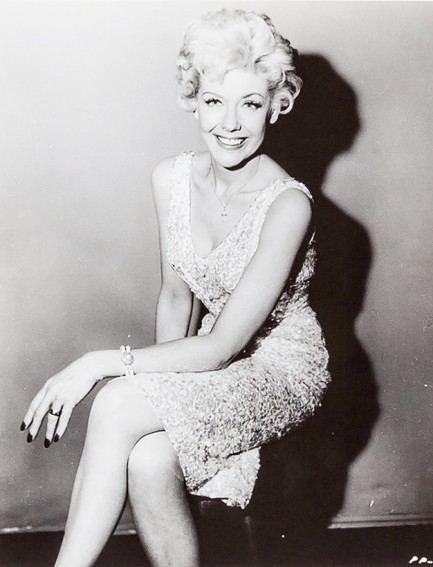
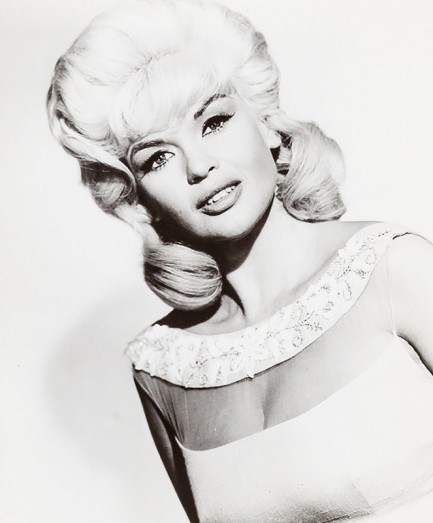
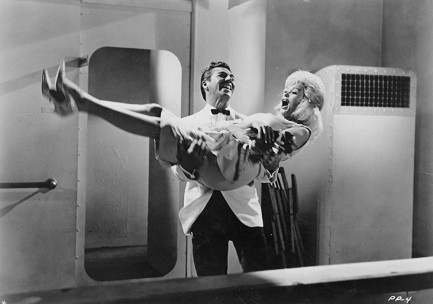
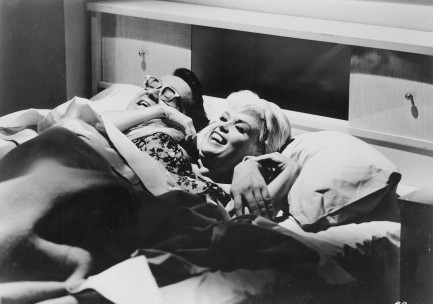
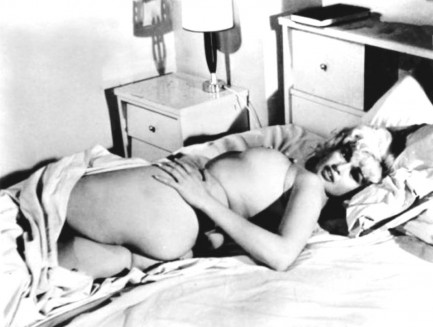
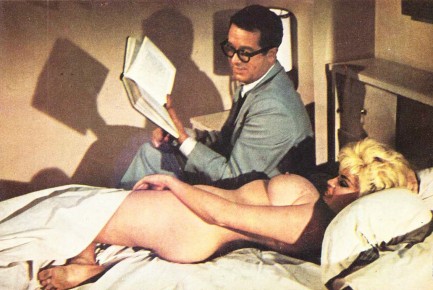
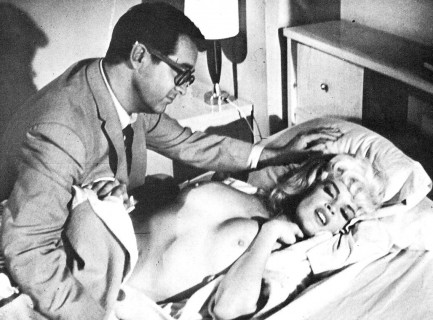

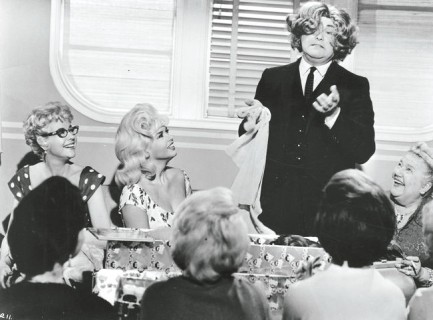
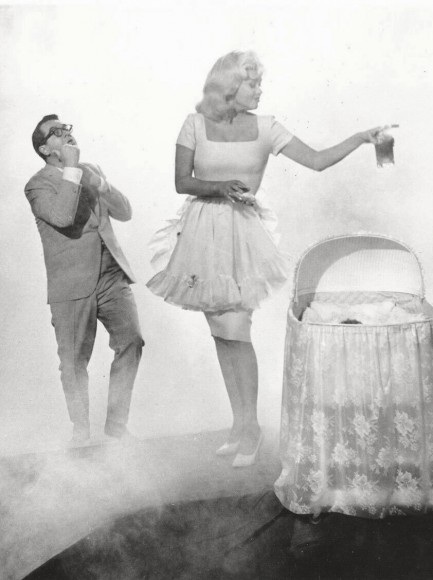
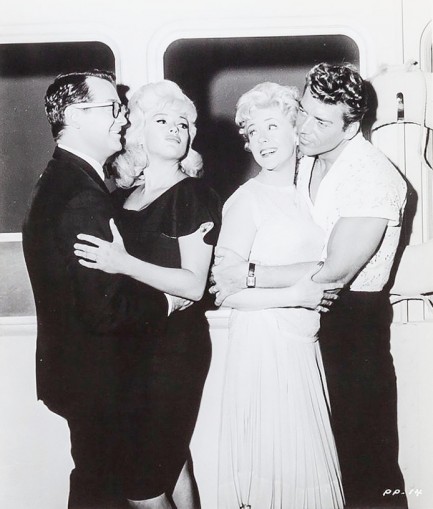
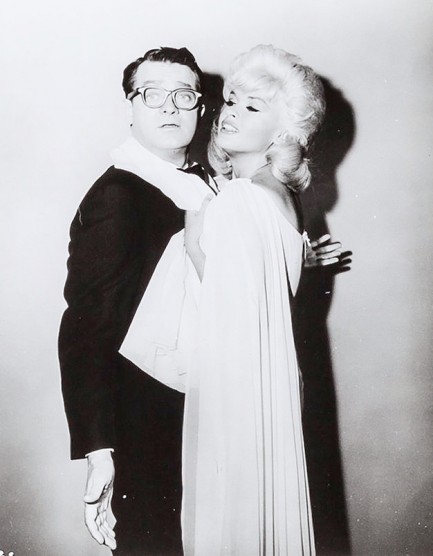
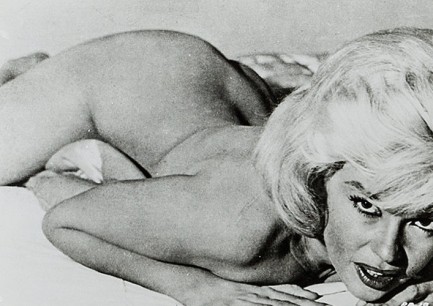
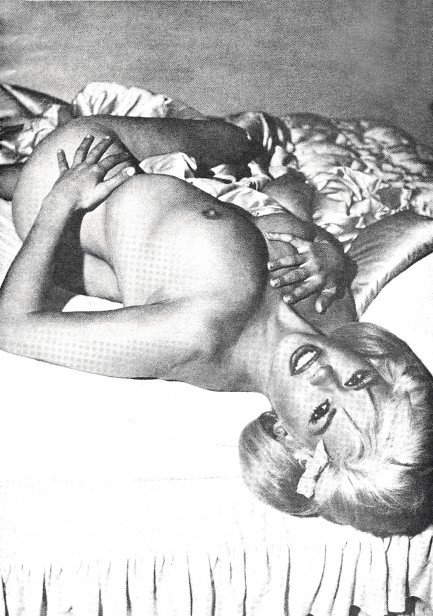
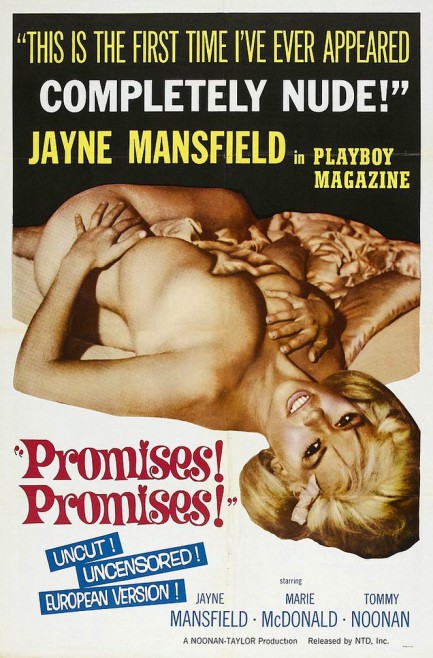
| Hollywoodland | Feb 8 2021 |

They should have taken a bigger boat.
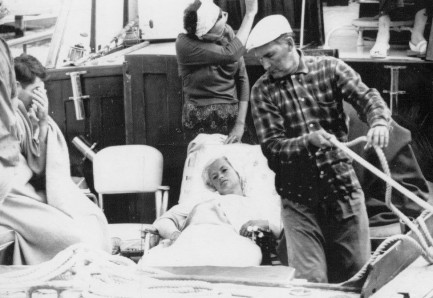
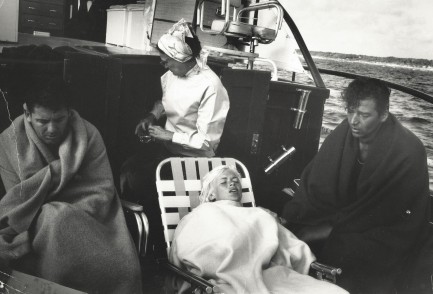
Today in 1962 Jayne Mansfield, while vacationing in the balmy Bahama Islands, failed to turn up for several evening appointments after having gone water skiing with her husband Mickey Hargitay and press agent Jack Drury. All three were feared lost at sea when the seventeen-foot motorboat they had rented was found adrift and capsized. At sundown the craft was towed to Nassau and the world waited for news. None came that night. The next morning's search for Mansfield and her companions involved four-hundred people, including the Nassau Air-Sea Rescue Squadron. Later that day a searcher flying overhead spotted a water ski floating near Rose Island, a stretch of sand about fifteen miles from Nassau. It was on the eastern end of the island that Mansfield, Hargitay, and Drury were finally found.
By this time the press had descended upon Nassau, and the spectacle of Mansfield being conducted to shore, weak and in tears, was witnessed by scores of journalists and photographers. The trio told the world a harrowing tale. Mansfield fell from her water skis, and Hargitay swam to retrieve her while Drury circled in the boat. At that point Drury saw sharks, and as they rushed to lift Mansfield into the boat it overturned. Hargitay and Drury continued trying to push Mansfield onto the now upside down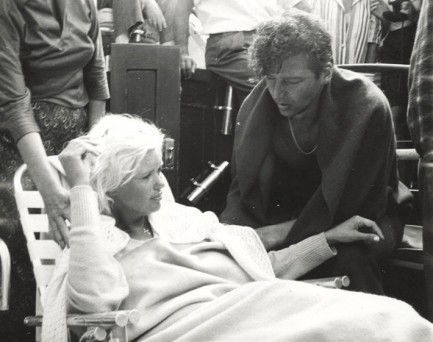 vessel, but at that point things went from bad to worse when she passed out. They got her atop the boat but could do nothing but drift. They bobbed on the waters for hours until they neared a small coral reef, decided to brave the sharks, and swam for it. There they spent the night, lacking supplies of any sort, with the tide rising until they were almost back in the sea again. At daybreak they saw that Rose Island was nearby. With the tide out, they were able to walk, wade, and swim to it.
vessel, but at that point things went from bad to worse when she passed out. They got her atop the boat but could do nothing but drift. They bobbed on the waters for hours until they neared a small coral reef, decided to brave the sharks, and swam for it. There they spent the night, lacking supplies of any sort, with the tide rising until they were almost back in the sea again. At daybreak they saw that Rose Island was nearby. With the tide out, they were able to walk, wade, and swim to it.
 vessel, but at that point things went from bad to worse when she passed out. They got her atop the boat but could do nothing but drift. They bobbed on the waters for hours until they neared a small coral reef, decided to brave the sharks, and swam for it. There they spent the night, lacking supplies of any sort, with the tide rising until they were almost back in the sea again. At daybreak they saw that Rose Island was nearby. With the tide out, they were able to walk, wade, and swim to it.
vessel, but at that point things went from bad to worse when she passed out. They got her atop the boat but could do nothing but drift. They bobbed on the waters for hours until they neared a small coral reef, decided to brave the sharks, and swam for it. There they spent the night, lacking supplies of any sort, with the tide rising until they were almost back in the sea again. At daybreak they saw that Rose Island was nearby. With the tide out, they were able to walk, wade, and swim to it.Mansfield's stranding and rescue was a huge story, but there were many who said it was a publicity stunt. It's an interesting take on the event, considering the attending physician at Rassin Hospital, whose name was Dr. Meyer Rassin—he founded the facility—said Mansfield suffered from “quite severe exposure, and the effects of bites from numerous mosquitoes and sand flies.” Having dealt with Caribbean sand flies ourselves, we can tell you nobody would willingly put themselves through the hell of being feasted on by them. But on the other hand, sand fly bites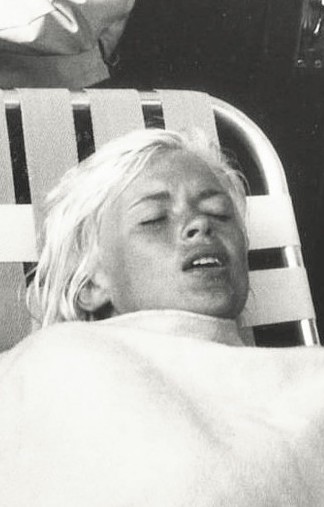

itch and swell, and when scratched they break open and bleed, yet Mansfield doesn't look particularly marked. On the other-other hand, doesn't dragging a local pilot and the respected founder of the island hospital into a fake near-death experience defy credulity?
But maybe two things were true at the same time. Maybe it started as a stunt. Maybe Mansfield and company motored to Rose Island, purposely turned the boat over and set it adrift, then waited for the pilot they'd selected to fly over the next morning. Maybe they even had food and water, and hunkered down for a night under the Caribbean stars while chortling over the free press coverage they were going to generate. But maybe they had failed to consider the sand fly aspect, and Mansfield really was in a sorry state when found, which means Dr. Rassin was being truthful. It's possible.
To us the biggest hole in Mansfield's story is the accidental capsizing of a boat seventeen feet long that's weighed down by an outboard motor. It takes serious work to overturn a floating canoe, let alone a waterskiing boat. But Mansfield was a hefty woman, Hargitay was a bodybuilder, and with Drury leaning waaaay out over the boat's gunwale, maybe they really did accidentally flip it. We'll never know what happened, which means Mansfield's big Bahamian adventure will always be a subject of speculation. But you now what? The truth is often banal. A mystery is so much more fun.

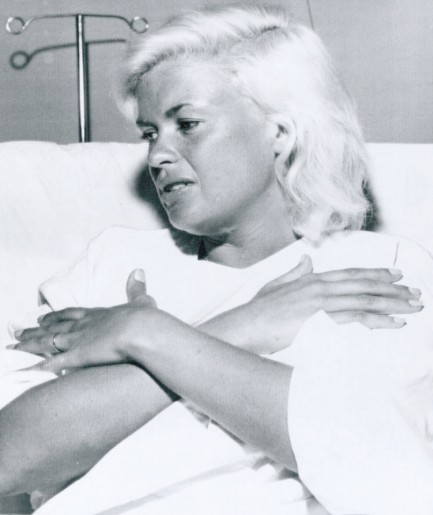
| Vintage Pulp | Jul 29 2020 |

Mansfield and her crew try to steal a million.
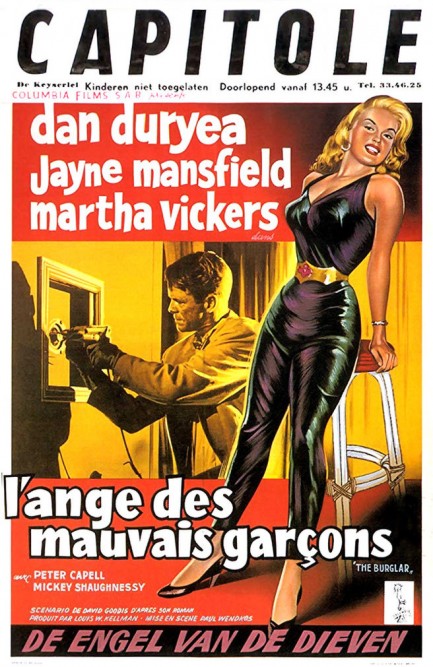
This fantastic Belgian poster with lettering in French and Dutch was made for the 1957 film noir L'Ange des mauvais garçons, better known as The Burglar. Well, better known is relative. The movie is somewhat obscure but it shouldn't be—it's a film noir clinic, and this great promo, which was made for its run at the Ciné Capitole in Antwerp, befits such an artful movie. It's unsigned, so the creator will have to remain unrecognized for now. Conversely, we think the movie will garner more recognition as time passes. Jayne Mansfield co-stars but don't get your hopes up—she doesn't wear a black jumpsuit. Not even close. You can read more about the movie here.
| Intl. Notebook | May 12 2020 |

Hitchcock says no festival for you this year!
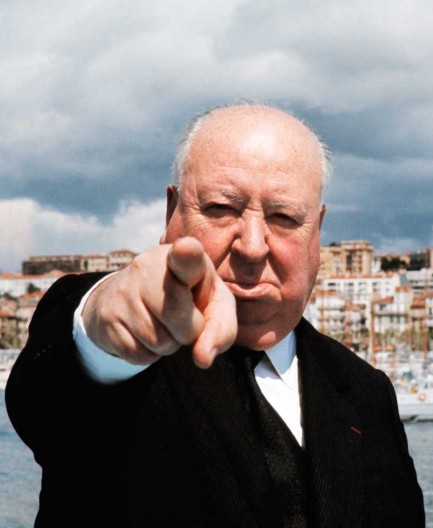
The 73rd edition of the Festival de Cannes, aka the Cannes Film Festival, would have kicked off today in the south of France, but was cancelled a while back. It's just one of a wave of event cancellations that will cascade through the year. Festivals as diverse as Burning Man and San Fermin, aka the Running of the Bulls, have also been shelved. But getting back to Cannes, we thought this would be a good moment to commemorate past fests with some historical photos. Above you see Alfred Hitchcock on a boat with the town in the background, in 1972, and below are about fifty pix from the 1940s through 1970s, documenting various iconic moments, and a few quieter ones. Maybe the Cannes Film Festival will back next year, maybe not. At this point, predicting anything is an exercise in futility. But at least we'll always have the memories.
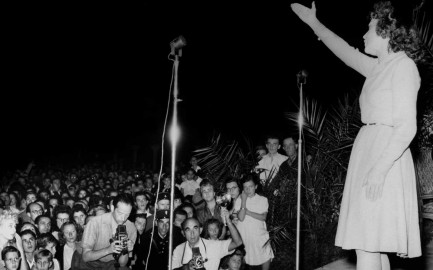
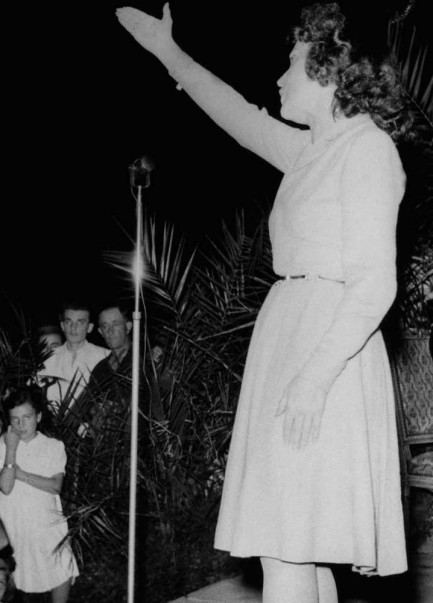 Edith Piaf sings on the terrace of the Carlton Hotel on the iconic Boulevard de la Croisette at the first Festival de Cannes to be held under that name, in 1946. Back then the event took place in September and October, but would shift to May a bit later.
Edith Piaf sings on the terrace of the Carlton Hotel on the iconic Boulevard de la Croisette at the first Festival de Cannes to be held under that name, in 1946. Back then the event took place in September and October, but would shift to May a bit later.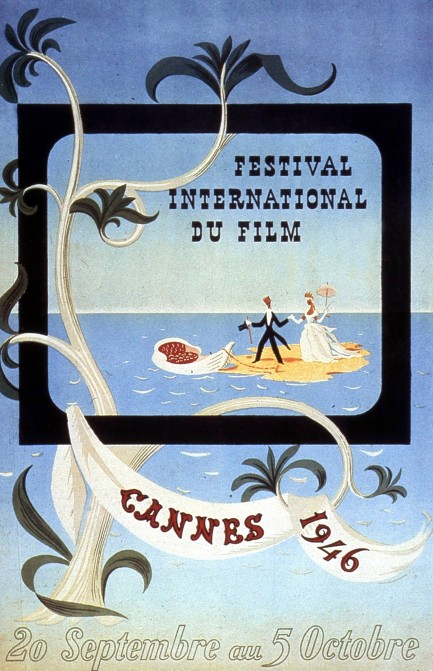
 Diana Dors and Ginger Rogers arrive at the fest the only way anyone should—breezing along the beachfront in a convertible, in 1956, with an unknown driver.
Diana Dors and Ginger Rogers arrive at the fest the only way anyone should—breezing along the beachfront in a convertible, in 1956, with an unknown driver.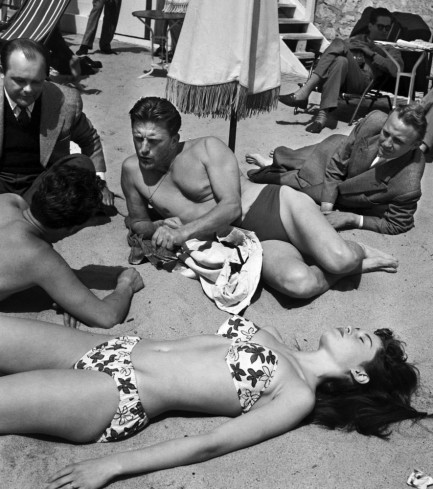 Kirk Douglas holds court on the beach in 1953, and Brigitte Bardot soaks up rays in the foreground.
Kirk Douglas holds court on the beach in 1953, and Brigitte Bardot soaks up rays in the foreground.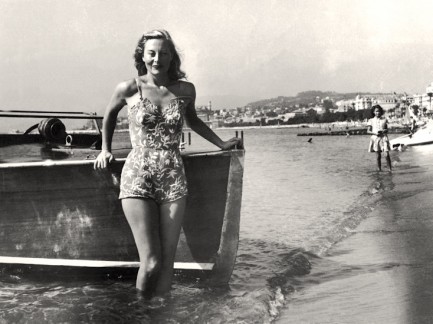 Michele Morgan poses at the first Festival in 1946. Photo ops of this sort were essential sources of publicity for stars, and would soon become opportunities for non-stars seeking to be discovered.
Michele Morgan poses at the first Festival in 1946. Photo ops of this sort were essential sources of publicity for stars, and would soon become opportunities for non-stars seeking to be discovered.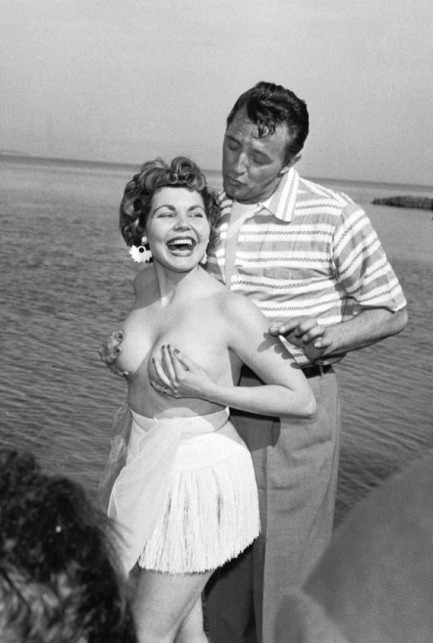 Case in point. Robert Mitchum poses with actress Simone Sylva in 1954. Sylva was allegedly not supposed to be there, but shucked her top and photo-bombed Douglas in an attempt to raise her profile. It didn't work. She made only a couple of credited movie appearances after her topless stunt.
Case in point. Robert Mitchum poses with actress Simone Sylva in 1954. Sylva was allegedly not supposed to be there, but shucked her top and photo-bombed Douglas in an attempt to raise her profile. It didn't work. She made only a couple of credited movie appearances after her topless stunt.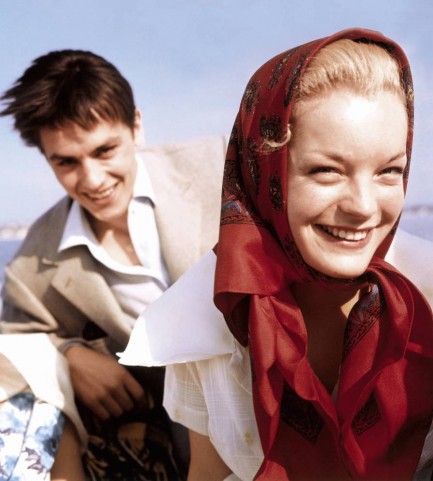 Romy Schneider and Alain Delon at the 1959 fest.
Romy Schneider and Alain Delon at the 1959 fest.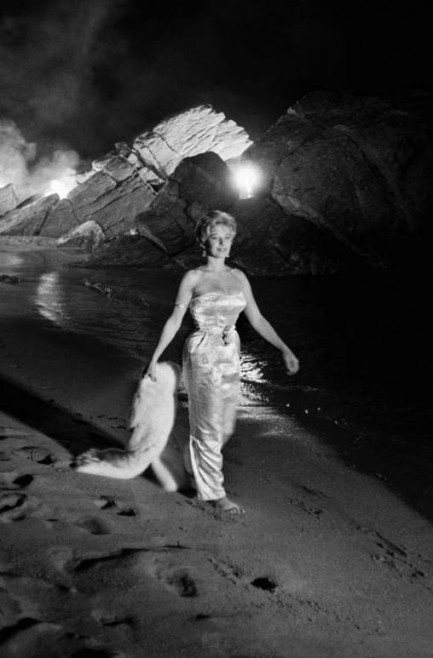 An unidentified model or actress poses in the style of Anita Ekberg from La dolce vita in 1960. This looks like it was shot at Plage du Midi, which is a beach located a little ways west of the Cannes town center.
An unidentified model or actress poses in the style of Anita Ekberg from La dolce vita in 1960. This looks like it was shot at Plage du Midi, which is a beach located a little ways west of the Cannes town center. A unidentified partygoer is tossed into a swimming pool after La Dolce Vita won the the 1960 Palme d’Or. The Festival is almost as well known for legendary parties as for legendary film premieres.
A unidentified partygoer is tossed into a swimming pool after La Dolce Vita won the the 1960 Palme d’Or. The Festival is almost as well known for legendary parties as for legendary film premieres.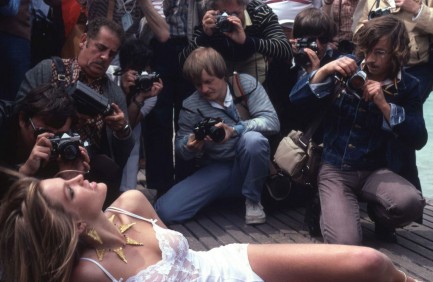
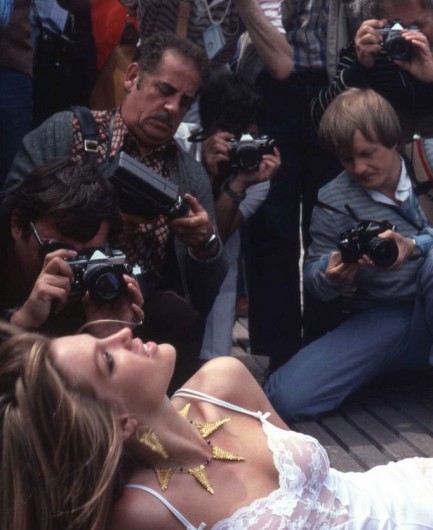 Another unidentified model or actress poses on the boardwalk in 1979. Generally, you don't have to be known to draw a crowd of photographers—you just have to be nearly bare. She's wearing lingerie, so that explains the interest, though this is modest garb for a Cannes publicity stunt. It's never a surprise to see a headline-seeking film hopeful strip all the way down to a string ficelle féminin, or thong, which is the limit of what is legal in Cannes
Another unidentified model or actress poses on the boardwalk in 1979. Generally, you don't have to be known to draw a crowd of photographers—you just have to be nearly bare. She's wearing lingerie, so that explains the interest, though this is modest garb for a Cannes publicity stunt. It's never a surprise to see a headline-seeking film hopeful strip all the way down to a string ficelle féminin, or thong, which is the limit of what is legal in Cannes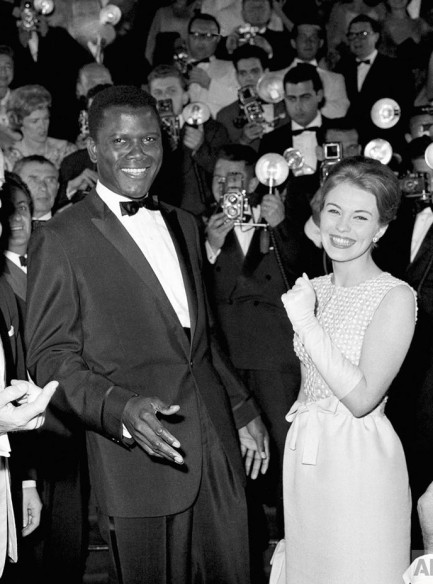 Sidney Poitier and Jean Seberg have a laugh in 1961. This was the year Poitier's flick Paris Blues was released, so it's possible he had jetted down from the capital for the Festival.
Sidney Poitier and Jean Seberg have a laugh in 1961. This was the year Poitier's flick Paris Blues was released, so it's possible he had jetted down from the capital for the Festival.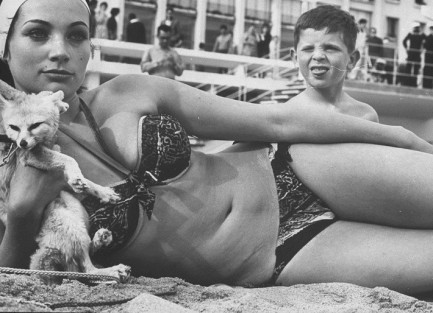 Philomène Toulouse relaxes on the sand in 1962 while a boy practices the classic French look of disgust he'll be using the rest of his life.
Philomène Toulouse relaxes on the sand in 1962 while a boy practices the classic French look of disgust he'll be using the rest of his life.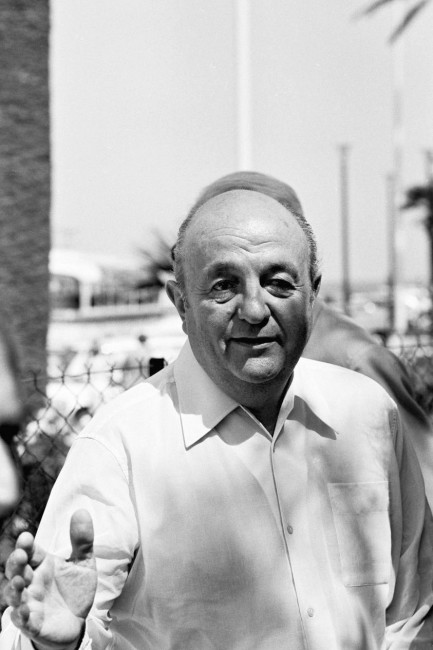 Actor Bernard Blier, 1975.
Actor Bernard Blier, 1975.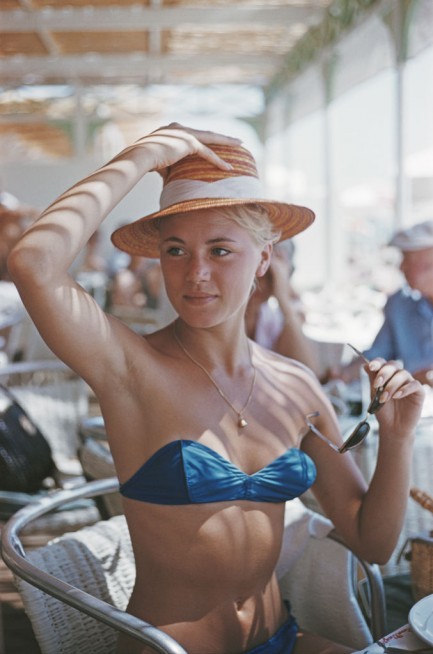 An unidentified bikini wearer boldly enjoys a lunch in a café on the Croisette, 1958.
An unidentified bikini wearer boldly enjoys a lunch in a café on the Croisette, 1958. Natalie Wood aboard a sailboat in 1962.
Natalie Wood aboard a sailboat in 1962.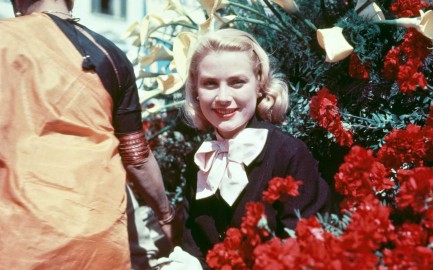
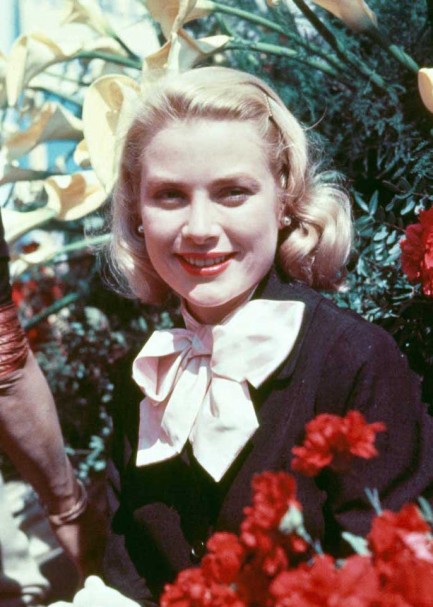 Grace Kelly, 1955.
Grace Kelly, 1955.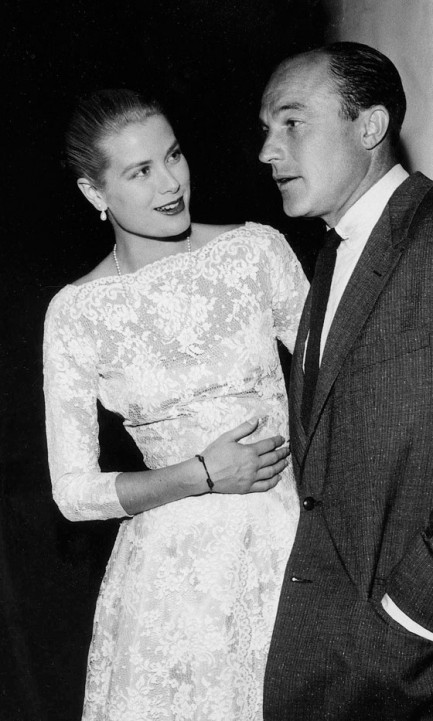 Kelly times two—Grace Kelly and Gene Kelly, hanging out, also in 1955.
Kelly times two—Grace Kelly and Gene Kelly, hanging out, also in 1955.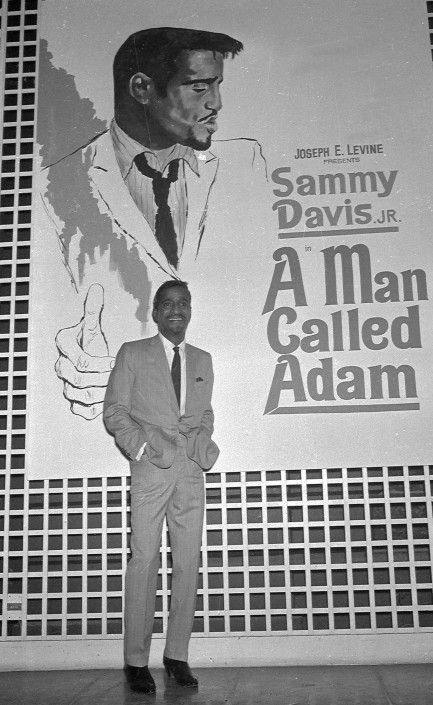 Sammy Davis, Jr. poses in front of a billboard promoting his film A Man Called Adam, 1966.
Sammy Davis, Jr. poses in front of a billboard promoting his film A Man Called Adam, 1966. Joan Scott gets sand between her toes in 1955. Scott is obscure. She isn't even the most famous Joan Scott anymore. The IMDB entry for the only Joan Scott near the appropriate age is for an actress born in 1920 who didn't begin acting until 1967. The Joan Scott above doesn't look thirty-five, though, and we doubt she would have been the subject of this somewhat well-known photo without parlaying it into a film appearance before twelve years had passed. So we don't think this is the Joan Scott referenced on IMDB.
Joan Scott gets sand between her toes in 1955. Scott is obscure. She isn't even the most famous Joan Scott anymore. The IMDB entry for the only Joan Scott near the appropriate age is for an actress born in 1920 who didn't begin acting until 1967. The Joan Scott above doesn't look thirty-five, though, and we doubt she would have been the subject of this somewhat well-known photo without parlaying it into a film appearance before twelve years had passed. So we don't think this is the Joan Scott referenced on IMDB.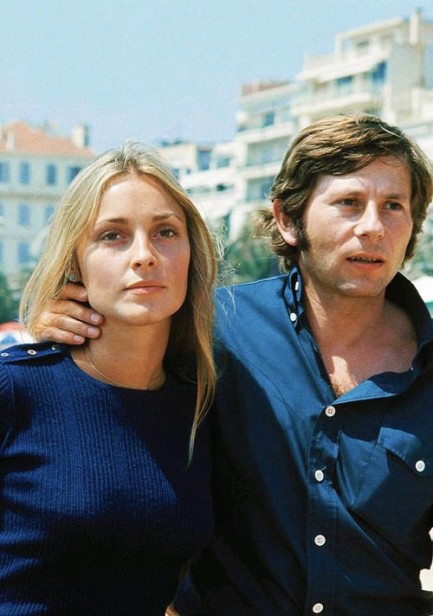
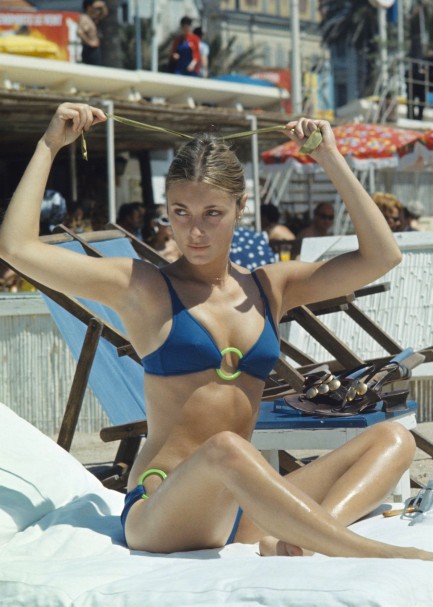 Sharon Tate, with Roman Polanski, and solo, 1968.
Sharon Tate, with Roman Polanski, and solo, 1968. Marlene Dietrich brings glamour to a tiki themed bar in 1958.
Marlene Dietrich brings glamour to a tiki themed bar in 1958.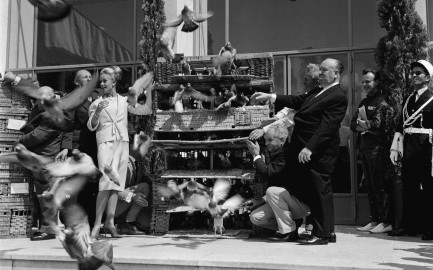
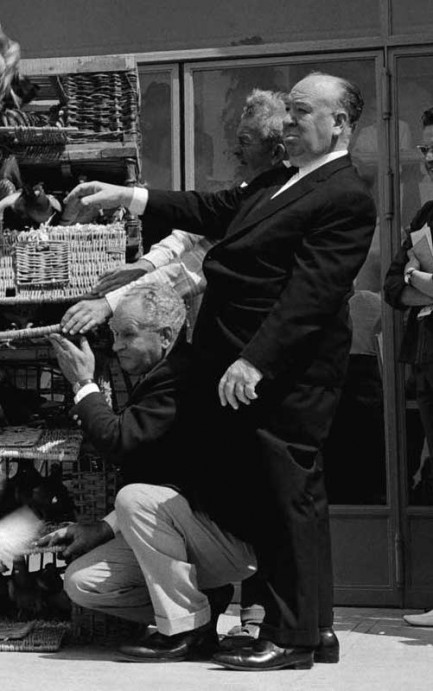 Tippi Hedren and Alfred Hitchcock release caged birds as a promo stunt for The Birds in 1963.
Tippi Hedren and Alfred Hitchcock release caged birds as a promo stunt for The Birds in 1963. Sophia Loren sits with husband Carlo Ponti, who was a member of the 1966 Festival jury.
Sophia Loren sits with husband Carlo Ponti, who was a member of the 1966 Festival jury.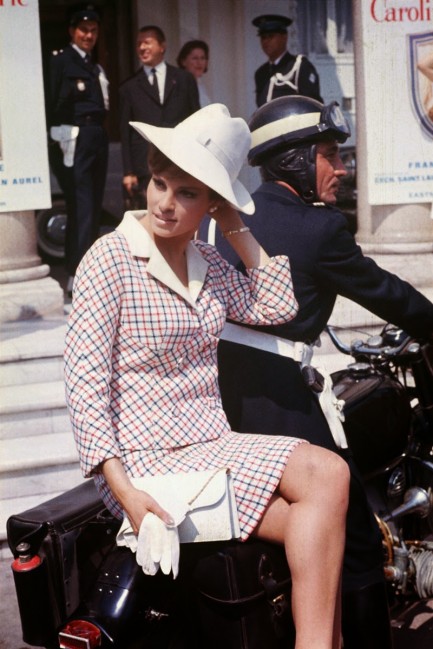 Raquel Welch poses on a motorcycle in 1966.
Raquel Welch poses on a motorcycle in 1966.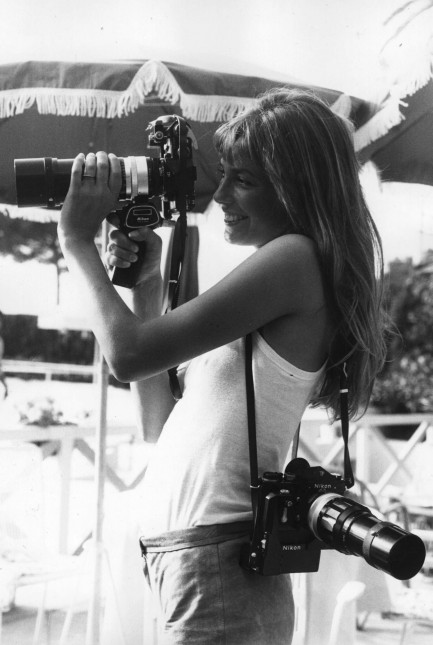 Jane Birkin takes aim with one of her cameras in 1975.
Jane Birkin takes aim with one of her cameras in 1975.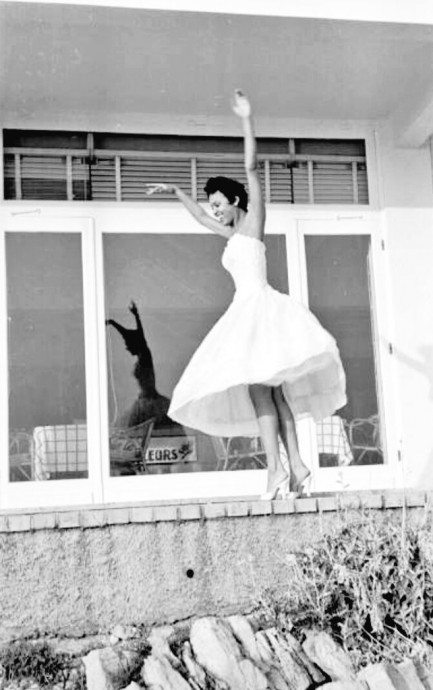 Dorothy Dandridge frolics in 1955, when she was promoting her film Carmen Jones.
Dorothy Dandridge frolics in 1955, when she was promoting her film Carmen Jones. Cinematic icon Catherine Deneuve and her sister Françoise Dorléac in 1965. Dorléac died in an automobile accident a couple of years later.
Cinematic icon Catherine Deneuve and her sister Françoise Dorléac in 1965. Dorléac died in an automobile accident a couple of years later.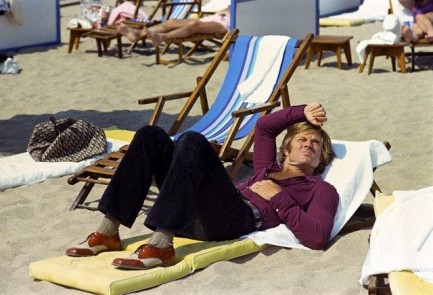 Robert Redford lounges on the beach in 1972. Based on his outfit you'd think he was in Cannes to promote The Sting, but he was actually there for his western Jeremiah Johnson, which screened May 7 of that year.
Robert Redford lounges on the beach in 1972. Based on his outfit you'd think he was in Cannes to promote The Sting, but he was actually there for his western Jeremiah Johnson, which screened May 7 of that year.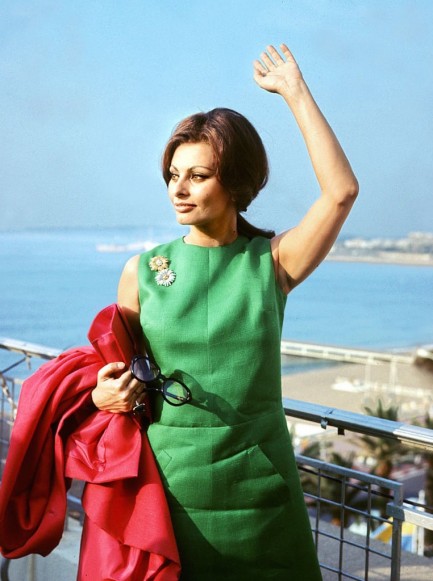 Sophia Loren waves to well-wishers in 1964.
Sophia Loren waves to well-wishers in 1964.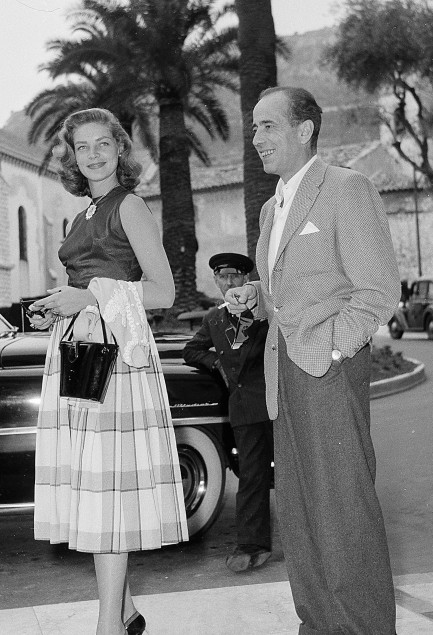 Bogie and Bacall paired up and looking distinguished in 1957.
Bogie and Bacall paired up and looking distinguished in 1957.
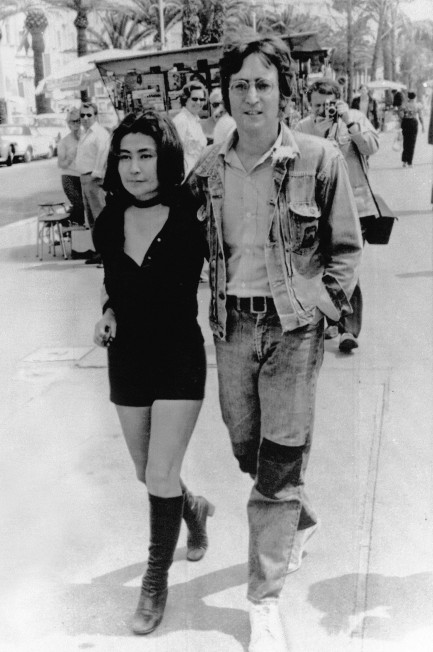 John and Cynthia Lennon in 1965, and John with Yoko Ono in 1971. Every story John told on that second trip probably started with, “When I was here with the first love of my life...” until Yoko smacked him across the mouth.
John and Cynthia Lennon in 1965, and John with Yoko Ono in 1971. Every story John told on that second trip probably started with, “When I was here with the first love of my life...” until Yoko smacked him across the mouth.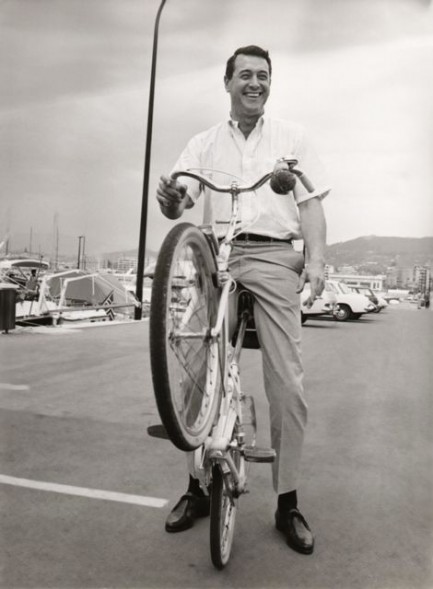 Rock Hudson and bicycle in 1966.
Rock Hudson and bicycle in 1966.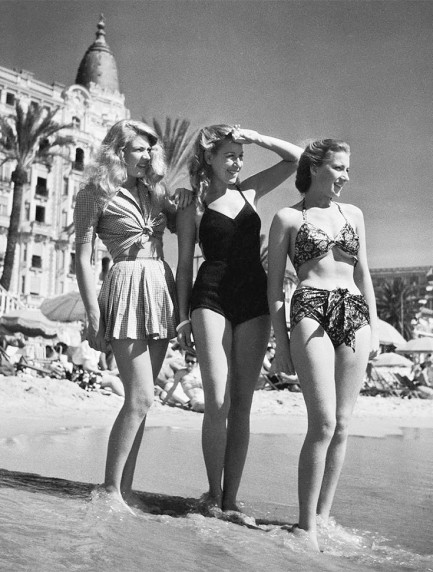 Unidentified actresses pose on the beach in 1947. To the rear is the Hotel Carlton, mentioned in the Edith Piaf image, built on the Croisette and finished in 1910.
Unidentified actresses pose on the beach in 1947. To the rear is the Hotel Carlton, mentioned in the Edith Piaf image, built on the Croisette and finished in 1910. George Baker, Bella Darvi (right—your right, not his), and an unknown acquaintance have a surfside run/photo op in 1956.
George Baker, Bella Darvi (right—your right, not his), and an unknown acquaintance have a surfside run/photo op in 1956. Jayne Mansfield and Russian actress Tatiana Samoïlova enjoy a toast in 1958. Mansfield probably shared the story of how she once made Sophia Loren stare at her boobs, and Samoïlova said, “Cheers to you—well played, you provocative American minx.”
Jayne Mansfield and Russian actress Tatiana Samoïlova enjoy a toast in 1958. Mansfield probably shared the story of how she once made Sophia Loren stare at her boobs, and Samoïlova said, “Cheers to you—well played, you provocative American minx.”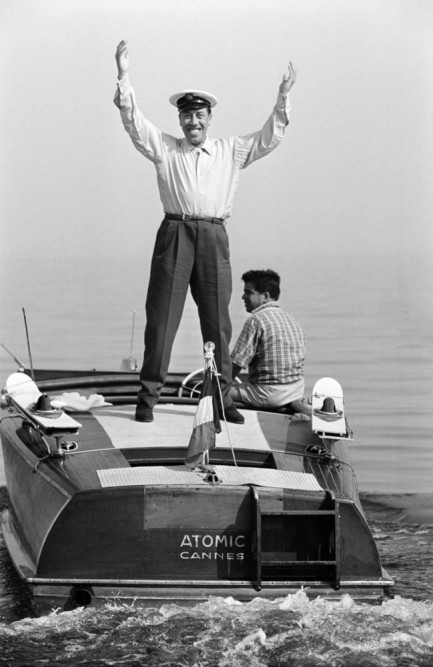 French actor Fernandel, whose real name was Fernand Contandin, on his boat Atomic in 1956.
French actor Fernandel, whose real name was Fernand Contandin, on his boat Atomic in 1956.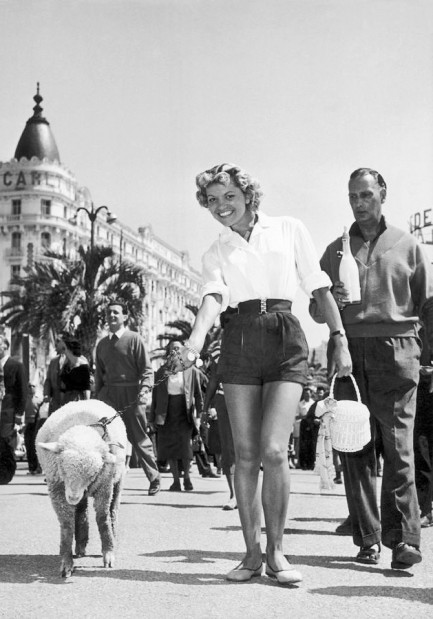 Arlette Patrick figures out a different way to generate publicity—by walking her sheep on the Croisette in 1955.
Arlette Patrick figures out a different way to generate publicity—by walking her sheep on the Croisette in 1955. A pair of water skiers show perfect form in 1955, as a battleship floats in the background.
A pair of water skiers show perfect form in 1955, as a battleship floats in the background.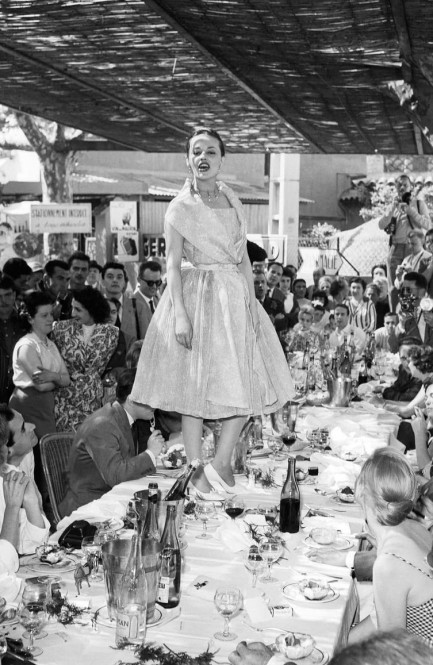 Jeanne Moreau, for reasons that are unclear, poses on a banquet table in 1958. Most sources descibe this in such a way as to make it seem spontaneous, but we have our doubts. It's a great shot, though.
Jeanne Moreau, for reasons that are unclear, poses on a banquet table in 1958. Most sources descibe this in such a way as to make it seem spontaneous, but we have our doubts. It's a great shot, though. Two unidentified women take in the scene from the terrace of the Hotel Carlton, 1958. This shot is usually said to portray two tourists, but the woman on the left is the same person as in the bikini lunch shot from earlier, which tells us she's a model or actress, and both photos are staged. Like we said, publicity is everything in Cannes.
Two unidentified women take in the scene from the terrace of the Hotel Carlton, 1958. This shot is usually said to portray two tourists, but the woman on the left is the same person as in the bikini lunch shot from earlier, which tells us she's a model or actress, and both photos are staged. Like we said, publicity is everything in Cannes.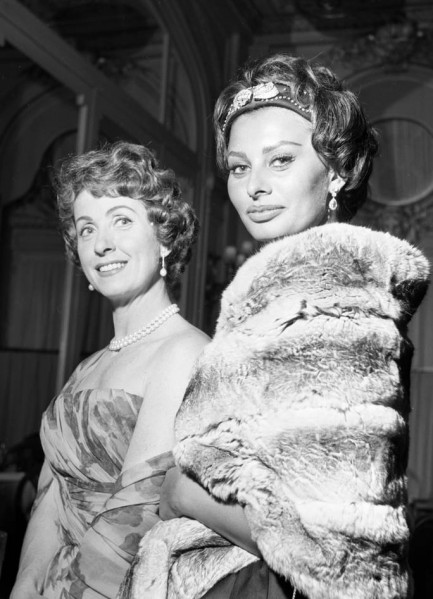
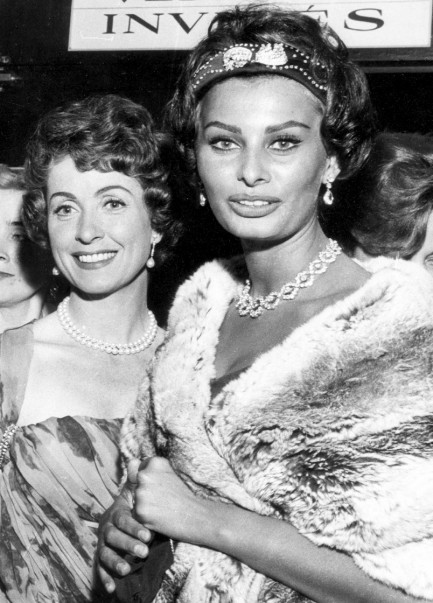 Danielle Darrieux and Sophia Loren at the 11th Cannes Film Festival, 1958.
Danielle Darrieux and Sophia Loren at the 11th Cannes Film Festival, 1958.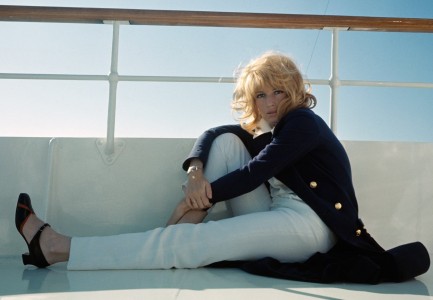 Italian actress Monica Vitti chills on a boat in 1968.
Italian actress Monica Vitti chills on a boat in 1968.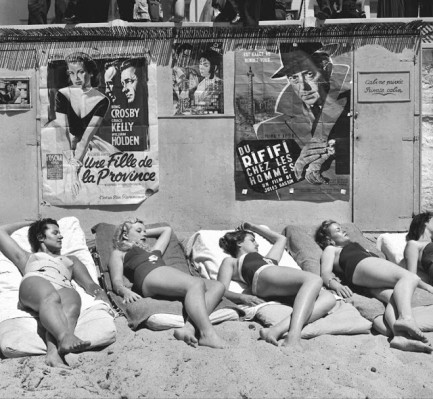 Aspiring stars catch some rays on the Croisette beach in 1955. The two large posters behind them are for The Country Girl with Grace Kelly, and Jules Dassin's Du rififi chez les hommes, both below.
Aspiring stars catch some rays on the Croisette beach in 1955. The two large posters behind them are for The Country Girl with Grace Kelly, and Jules Dassin's Du rififi chez les hommes, both below.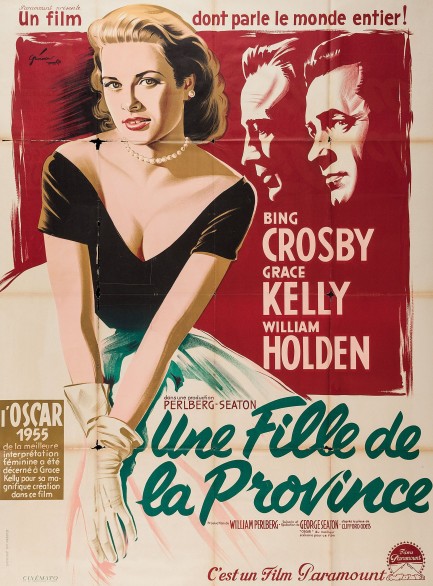
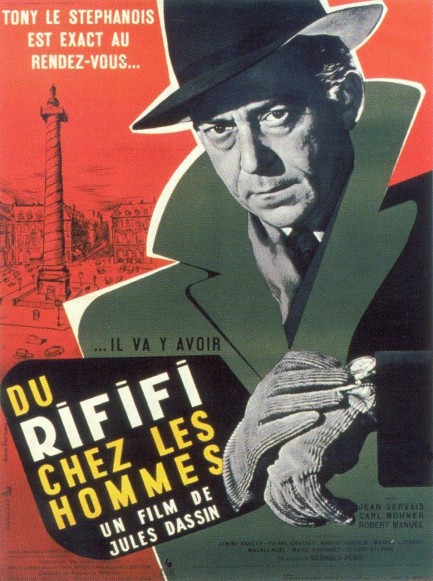
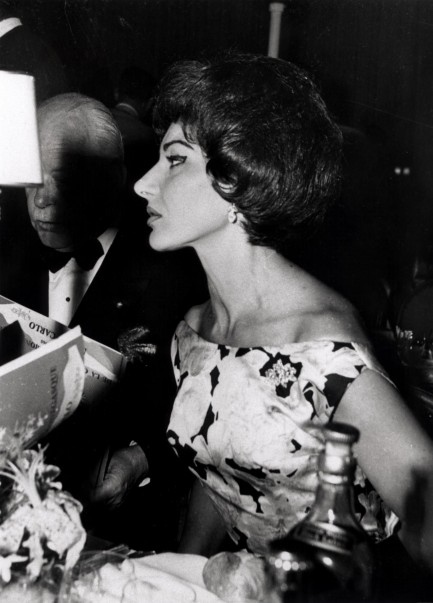 The renowned opera singer Maria Callas, 1960.
The renowned opera singer Maria Callas, 1960.FranceCannesFestival du CannesCannes Film FestivalPalme d’OrLa dolce vitaA Man Called AdamThe BirdsAlfred HitchcockEdith PiafDiana DorsGinger RogersKirk DouglasBrigitte BardotMichèle MorganRobert MitchumSimone SylvaRomy SchneiderAlain DelonSidney PoitierJean SebergNatalie WoodGrace KellySammy Davis Jr.Sharon TateRoman PolanskiMarlene DietrichTippi HedrenGene KellyMaria CallasSophia LorenCarlo PontiRaquel WelchJane BirkinJoan ScottDorothy DandridgeRobert RedfordJohn LennonCynthia LennonYoko OnoRock HudsonLauren BacallHumphrey BogartGeorge BakerBella DarviJayne MansfieldTatiana SamoïlovaCatherine DeneuveFrançoise DorléacFernandelArlette PatrickJeanne MoreauDanielle DarrieuxBernard BlierPhilomène ToulouseMonica Vittiposter artcinema
| Hollywoodland | Apr 24 2020 |

Sometimes you simply have to look.
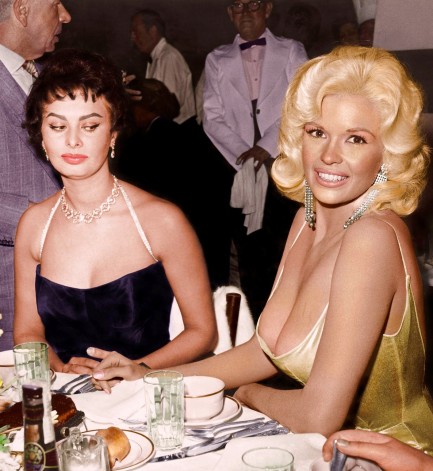
You know you shouldn't look at them. You try to direct your gaze where it belongs—at the band, or at the Champagne pyramid, or maybe at the roasted baby pig platter. You see people staring and know if you do too they'll all catch you. But the effort of not looking becomes a Sisyphean task. Lateral gravity becomes your enemy. Your eyes keep getting puuuuulled in that direction and you keep stopping them, just barely, by firing the reverse thrusters full power. But then, after many slow mintues of this torture, you figure, well screw this, maybe one day the planet will be in lockdown and this opportunity won't even exist. So you decide to take a really good look, just one, to get it out of the way, because if you don't you'll be fighting it all night. Plus she wants them to be looked at. Clearly. So you look—and flash! Someone takes a photo and your glance is immortalized as the evil side-eye of all time.
That moment happened April 12, 1957, as Sophia Loren attended a glittering Paramount Pictures dinner where she was the guest of honor. It was held at Romanoff's in Beverly Hills, a chic and popular restaurant, and Mansfield—being Mansfield—arrived last and sucked up the oxygen in the room like a magnesium fire. Every camera in the joint was following her—and by extension Loren, because the seating chart had placed them adjacent. Loren was a big star, but stars sometimes get trapped in other stars' orbits. Loren and Mansfield got locked into the same space-time continuum, eyes moved to boobs, and the infamous photo was shot. The images of the encounter were all in black and white. What you see above is a colorization, a pretty nice one, except the retoucher didn't do their homework. Mansfield's dress was pink that night. She nearly always wore pink. It was her favorite color. Even her house was pink.
The colorization below gets the dress right, and this second angle shows just how much skin Mansfield was revealing, which gives a clearer indication why Loren had to look. Mansfield's nipples were coming out. They had fishhooked Loren's eyes. She couldn't not look. Not not doing something is an ethical conundrum we've discussed before, and it's baffled some of the greatest minds of all time. As you might imagine, Loren hates the shot. Sometimes fans ask her to autograph it and she says she always refuses. The dinner that night was intended to welcome her to Hollywood. Well, she was welcomed in more ways than one. Mansfield showed her a surefire method for playing the celebrity game, by always making a big entrance—even if it meant almost making a big exit from her dress.
